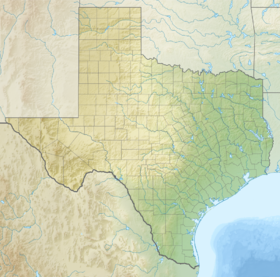Dallas

Dallas

Dallas, Texas | ||||||||||||||||||||||||||||||||||||||||||||||||||||||||||||
|---|---|---|---|---|---|---|---|---|---|---|---|---|---|---|---|---|---|---|---|---|---|---|---|---|---|---|---|---|---|---|---|---|---|---|---|---|---|---|---|---|---|---|---|---|---|---|---|---|---|---|---|---|---|---|---|---|---|---|---|---|
City | ||||||||||||||||||||||||||||||||||||||||||||||||||||||||||||
| City of Dallas | ||||||||||||||||||||||||||||||||||||||||||||||||||||||||||||
| Nicknames: Big D, D-Town, Triple D[5] | ||||||||||||||||||||||||||||||||||||||||||||||||||||||||||||
 Location within Dallas County | ||||||||||||||||||||||||||||||||||||||||||||||||||||||||||||
| Coordinates:32°46′45″N 96°48′32″W [244] | ||||||||||||||||||||||||||||||||||||||||||||||||||||||||||||
| Country | ||||||||||||||||||||||||||||||||||||||||||||||||||||||||||||
| State | ||||||||||||||||||||||||||||||||||||||||||||||||||||||||||||
| Counties | Dallas, Collin, Denton, Rockwall, Kaufman | |||||||||||||||||||||||||||||||||||||||||||||||||||||||||||
| Incorporated | February 2, 1856 | |||||||||||||||||||||||||||||||||||||||||||||||||||||||||||
| Government | ||||||||||||||||||||||||||||||||||||||||||||||||||||||||||||
| • Type | Council–Manager | |||||||||||||||||||||||||||||||||||||||||||||||||||||||||||
| • Body | Dallas City Council | |||||||||||||||||||||||||||||||||||||||||||||||||||||||||||
| • Mayor | Eric Johnson (D) | |||||||||||||||||||||||||||||||||||||||||||||||||||||||||||
| Area | ||||||||||||||||||||||||||||||||||||||||||||||||||||||||||||
| • City | 385.8 sq mi (999.3 km2) | |||||||||||||||||||||||||||||||||||||||||||||||||||||||||||
| • Land | 340.5 sq mi (881.9 km2) | |||||||||||||||||||||||||||||||||||||||||||||||||||||||||||
| • Water | 45.3 sq mi (117.4 km2) | |||||||||||||||||||||||||||||||||||||||||||||||||||||||||||
| • Urban | 1,407.2 sq mi (3,645 km2) | |||||||||||||||||||||||||||||||||||||||||||||||||||||||||||
| Elevation | 430 ft (131 m) | |||||||||||||||||||||||||||||||||||||||||||||||||||||||||||
| Population | ||||||||||||||||||||||||||||||||||||||||||||||||||||||||||||
| • City | 1,197,816 | |||||||||||||||||||||||||||||||||||||||||||||||||||||||||||
| • Estimate (2018)[7] | 1,345,047 | |||||||||||||||||||||||||||||||||||||||||||||||||||||||||||
| • Rank | (US: 9th) | |||||||||||||||||||||||||||||||||||||||||||||||||||||||||||
| • Density | 3,876/sq mi (1,497/km2) | |||||||||||||||||||||||||||||||||||||||||||||||||||||||||||
| • Urban | 5,121,892 (6th) | |||||||||||||||||||||||||||||||||||||||||||||||||||||||||||
| • Metro | 7,233,323 (4th) | |||||||||||||||||||||||||||||||||||||||||||||||||||||||||||
| • CSA | 7,673,305 (7th) | |||||||||||||||||||||||||||||||||||||||||||||||||||||||||||
| • Demonym | Dallasite | |||||||||||||||||||||||||||||||||||||||||||||||||||||||||||
| Time zone | UTC−6 (Central) | |||||||||||||||||||||||||||||||||||||||||||||||||||||||||||
| • Summer (DST) | UTC−5 (Central) | |||||||||||||||||||||||||||||||||||||||||||||||||||||||||||
| ZIP codes | ZIP codes[8]
| |||||||||||||||||||||||||||||||||||||||||||||||||||||||||||
| Area codes | 214, 469, 972, 682, 817[9][10] | |||||||||||||||||||||||||||||||||||||||||||||||||||||||||||
| FIPS code | 48-19000[11] | |||||||||||||||||||||||||||||||||||||||||||||||||||||||||||
| GNIS feature ID | 1380944[12] | |||||||||||||||||||||||||||||||||||||||||||||||||||||||||||
| Primary airport | Dallas/Fort Worth International Airport | |||||||||||||||||||||||||||||||||||||||||||||||||||||||||||
| Secondary airport | Dallas Love Field | |||||||||||||||||||||||||||||||||||||||||||||||||||||||||||
| Interstates | ||||||||||||||||||||||||||||||||||||||||||||||||||||||||||||
| U.S. routes | ||||||||||||||||||||||||||||||||||||||||||||||||||||||||||||
| Commuter rail | Trinity Railway Express | |||||||||||||||||||||||||||||||||||||||||||||||||||||||||||
| Rapid transit | DART Light Rail | |||||||||||||||||||||||||||||||||||||||||||||||||||||||||||
| Website | dallascityhall.com [245] | |||||||||||||||||||||||||||||||||||||||||||||||||||||||||||
| Dallas, Texas | ||||||||||||||||||||||||||||||||||||||||||||||||||||||||||||
| Climate chart (explanation) | ||||||||||||||||||||||||||||||||||||||||||||||||||||||||||||
| ||||||||||||||||||||||||||||||||||||||||||||||||||||||||||||
| ||||||||||||||||||||||||||||||||||||||||||||||||||||||||||||
J | F | M | A | M | J | J | A | S | O | N | D | |||||||||||||||||||||||||||||||||||||||||||||||||
2.1 57 37 | 2.6 61 41 | 3.5 69 49 | 3.1 77 56 | 4.9 84 65 | 4.1 92 73 | 2.2 96 77 | 1.9 96 77 | 2.8 89 69 | 4.8 79 58 | 2.9 67 48 | 2.7 58 39 | |||||||||||||||||||||||||||||||||||||||||||||||||
| Average max. and min. temperatures in °F | ||||||||||||||||||||||||||||||||||||||||||||||||||||||||||||
| Precipitation totals in inches | ||||||||||||||||||||||||||||||||||||||||||||||||||||||||||||
| Metric conversion | ||||||||||||||||||||||||||||||||||||||||||||||||||||||||||||
J | F | M | A | M | J | J | A | S | O | N | D | |||||||||||||||||||||||||||||||||||||||||||||||||
52 14 3 | 66 16 5 | 89 20 9 | 78 25 13 | 125 29 19 | 104 33 23 | 56 36 25 | 47 36 25 | 72 32 21 | 122 26 15 | 73 20 9 | 70 14 4 | |||||||||||||||||||||||||||||||||||||||||||||||||
| Average max. and min. temperatures in °C | ||||||||||||||||||||||||||||||||||||||||||||||||||||||||||||
| Precipitation totals in mm | ||||||||||||||||||||||||||||||||||||||||||||||||||||||||||||
Dallas (/ˈdæləs/) is a city in the U.S. state of Texas and the seat of Dallas County, with portions extending into Collin, Denton, Kaufman and Rockwall counties. With an estimated 2018 population of 1,345,047,[13] it is the ninth most-populous city in the U.S.[14] and third in Texas after Houston and San Antonio.[15] Located in North Texas, the city of Dallas is the main core of the largest metropolitan area in the Southern United States and the largest inland metropolitan area in the U.S. that lacks any navigable link to the sea.[1] It is the most populous city in the Dallas–Fort Worth metroplex, the fourth-largest metropolitan area in the country at 7.5 million people as of 2018.[16] The city's combined statistical area is the seventh-largest in the U.S. as of 2017, with 7,846,293 residents.[17]
Dallas and nearby Fort Worth were initially developed due to the construction of major railroad lines through the area allowing access to cotton, cattle and later oil in North and East Texas. The construction of the Interstate Highway System reinforced Dallas's prominence as a transportation hub, with four major interstate highways converging in the city and a fifth interstate loop around it. Dallas then developed as a strong industrial and financial center and a major inland port, due to the convergence of major railroad lines, interstate highways and the construction of Dallas/Fort Worth International Airport, one of the largest and busiest airports in the world.[18]
Dallas is a "beta(+)" global city.[19][20] Dominant sectors of its diverse economy include defense, financial services, information technology, telecommunications, and transportation.[21] Dallas is home to 9 Fortune 500 companies within the city limits. The Dallas–Fort Worth metroplex hosts additional Fortune 500 companies, including American Airlines (Fort Worth), ExxonMobil (Irving), and J. C. Penney (Plano). Over 41 colleges and universities are in its metropolitan area which is the most of any metropolitan area in Texas. The city has a population from a myriad of ethnic and religious backgrounds and one of the largest LGBT communities in the U.S.[22] WalletHub named Dallas the fifth most-diverse city in the U.S. in 2018.[23]
Dallas, Texas | ||||||||||||||||||||||||||||||||||||||||||||||||||||||||||||
|---|---|---|---|---|---|---|---|---|---|---|---|---|---|---|---|---|---|---|---|---|---|---|---|---|---|---|---|---|---|---|---|---|---|---|---|---|---|---|---|---|---|---|---|---|---|---|---|---|---|---|---|---|---|---|---|---|---|---|---|---|
City | ||||||||||||||||||||||||||||||||||||||||||||||||||||||||||||
| City of Dallas | ||||||||||||||||||||||||||||||||||||||||||||||||||||||||||||
| Nicknames: Big D, D-Town, Triple D[5] | ||||||||||||||||||||||||||||||||||||||||||||||||||||||||||||
 Location within Dallas County | ||||||||||||||||||||||||||||||||||||||||||||||||||||||||||||
| Coordinates:32°46′45″N 96°48′32″W [244] | ||||||||||||||||||||||||||||||||||||||||||||||||||||||||||||
| Country | ||||||||||||||||||||||||||||||||||||||||||||||||||||||||||||
| State | ||||||||||||||||||||||||||||||||||||||||||||||||||||||||||||
| Counties | Dallas, Collin, Denton, Rockwall, Kaufman | |||||||||||||||||||||||||||||||||||||||||||||||||||||||||||
| Incorporated | February 2, 1856 | |||||||||||||||||||||||||||||||||||||||||||||||||||||||||||
| Government | ||||||||||||||||||||||||||||||||||||||||||||||||||||||||||||
| • Type | Council–Manager | |||||||||||||||||||||||||||||||||||||||||||||||||||||||||||
| • Body | Dallas City Council | |||||||||||||||||||||||||||||||||||||||||||||||||||||||||||
| • Mayor | Eric Johnson (D) | |||||||||||||||||||||||||||||||||||||||||||||||||||||||||||
| Area | ||||||||||||||||||||||||||||||||||||||||||||||||||||||||||||
| • City | 385.8 sq mi (999.3 km2) | |||||||||||||||||||||||||||||||||||||||||||||||||||||||||||
| • Land | 340.5 sq mi (881.9 km2) | |||||||||||||||||||||||||||||||||||||||||||||||||||||||||||
| • Water | 45.3 sq mi (117.4 km2) | |||||||||||||||||||||||||||||||||||||||||||||||||||||||||||
| • Urban | 1,407.2 sq mi (3,645 km2) | |||||||||||||||||||||||||||||||||||||||||||||||||||||||||||
| Elevation | 430 ft (131 m) | |||||||||||||||||||||||||||||||||||||||||||||||||||||||||||
| Population | ||||||||||||||||||||||||||||||||||||||||||||||||||||||||||||
| • City | 1,197,816 | |||||||||||||||||||||||||||||||||||||||||||||||||||||||||||
| • Estimate (2018)[7] | 1,345,047 | |||||||||||||||||||||||||||||||||||||||||||||||||||||||||||
| • Rank | (US: 9th) | |||||||||||||||||||||||||||||||||||||||||||||||||||||||||||
| • Density | 3,876/sq mi (1,497/km2) | |||||||||||||||||||||||||||||||||||||||||||||||||||||||||||
| • Urban | 5,121,892 (6th) | |||||||||||||||||||||||||||||||||||||||||||||||||||||||||||
| • Metro | 7,233,323 (4th) | |||||||||||||||||||||||||||||||||||||||||||||||||||||||||||
| • CSA | 7,673,305 (7th) | |||||||||||||||||||||||||||||||||||||||||||||||||||||||||||
| • Demonym | Dallasite | |||||||||||||||||||||||||||||||||||||||||||||||||||||||||||
| Time zone | UTC−6 (Central) | |||||||||||||||||||||||||||||||||||||||||||||||||||||||||||
| • Summer (DST) | UTC−5 (Central) | |||||||||||||||||||||||||||||||||||||||||||||||||||||||||||
| ZIP codes | ZIP codes[8]
| |||||||||||||||||||||||||||||||||||||||||||||||||||||||||||
| Area codes | 214, 469, 972, 682, 817[9][10] | |||||||||||||||||||||||||||||||||||||||||||||||||||||||||||
| FIPS code | 48-19000[11] | |||||||||||||||||||||||||||||||||||||||||||||||||||||||||||
| GNIS feature ID | 1380944[12] | |||||||||||||||||||||||||||||||||||||||||||||||||||||||||||
| Primary airport | Dallas/Fort Worth International Airport | |||||||||||||||||||||||||||||||||||||||||||||||||||||||||||
| Secondary airport | Dallas Love Field | |||||||||||||||||||||||||||||||||||||||||||||||||||||||||||
| Interstates | ||||||||||||||||||||||||||||||||||||||||||||||||||||||||||||
| U.S. routes | ||||||||||||||||||||||||||||||||||||||||||||||||||||||||||||
| Commuter rail | Trinity Railway Express | |||||||||||||||||||||||||||||||||||||||||||||||||||||||||||
| Rapid transit | DART Light Rail | |||||||||||||||||||||||||||||||||||||||||||||||||||||||||||
| Website | dallascityhall.com [245] | |||||||||||||||||||||||||||||||||||||||||||||||||||||||||||
| Dallas, Texas | ||||||||||||||||||||||||||||||||||||||||||||||||||||||||||||
| Climate chart (explanation) | ||||||||||||||||||||||||||||||||||||||||||||||||||||||||||||
| ||||||||||||||||||||||||||||||||||||||||||||||||||||||||||||
| ||||||||||||||||||||||||||||||||||||||||||||||||||||||||||||
J | F | M | A | M | J | J | A | S | O | N | D | |||||||||||||||||||||||||||||||||||||||||||||||||
2.1 57 37 | 2.6 61 41 | 3.5 69 49 | 3.1 77 56 | 4.9 84 65 | 4.1 92 73 | 2.2 96 77 | 1.9 96 77 | 2.8 89 69 | 4.8 79 58 | 2.9 67 48 | 2.7 58 39 | |||||||||||||||||||||||||||||||||||||||||||||||||
| Average max. and min. temperatures in °F | ||||||||||||||||||||||||||||||||||||||||||||||||||||||||||||
| Precipitation totals in inches | ||||||||||||||||||||||||||||||||||||||||||||||||||||||||||||
| Metric conversion | ||||||||||||||||||||||||||||||||||||||||||||||||||||||||||||
J | F | M | A | M | J | J | A | S | O | N | D | |||||||||||||||||||||||||||||||||||||||||||||||||
52 14 3 | 66 16 5 | 89 20 9 | 78 25 13 | 125 29 19 | 104 33 23 | 56 36 25 | 47 36 25 | 72 32 21 | 122 26 15 | 73 20 9 | 70 14 4 | |||||||||||||||||||||||||||||||||||||||||||||||||
| Average max. and min. temperatures in °C | ||||||||||||||||||||||||||||||||||||||||||||||||||||||||||||
| Precipitation totals in mm | ||||||||||||||||||||||||||||||||||||||||||||||||||||||||||||
History
Preceded by thousands of years of varying cultures, the Caddo people inhabited the Dallas area before Spanish colonists claimed the territory of Texas in the 18th century as a part of the Viceroyalty of New Spain. Later, France also claimed the area but never established much settlement.
In 1819, the Adams-Onís Treaty between the United States and Spain defined the Red River as the northern boundary of New Spain, officially placing the future location of Dallas well within Spanish territory.[24] The area remained under Spanish rule until 1821, when Mexico declared independence from Spain, and the area was considered part of the Mexican state of Coahuila y Tejas. In 1836, Texians, with a majority of Anglo-American settlers, gained independence from Mexico and formed the Republic of Texas.[25]
Three years after Texas achieved independence, John Neely Bryan surveyed the area around present-day Dallas.[26] In 1839, accompanied by his dog and a Cherokee he called Ned, he planted a stake in the ground on a bluff located near three forks of the Trinity River and left.[27] Two years later, in 1841, he returned to establish a permanent settlement named Dallas. The origin of the name is uncertain. The official historical marker states it was named after Vice President George M. Dallas of Philadelphia, Pennsylvania. However, this is disputed. Other potential theories for the origin include his brother, Commodore Alexander James Dallas, as well as brothers Walter R. Dallas or James R. Dallas.[28][29] A further theory gives the origin as the village of Dallas, Moray, Scotland, similar to the way Houston, Texas was named after Sam Houston whose ancestors came from the Scottish village of Houston, Renfrewshire. The Republic of Texas was annexed by the United States in 1845 and Dallas County was established the following year. Dallas was formally incorporated as a city on February 2, 1856.[18]
In the mid-1800s, a group of French Socialists established La Réunion, a short-lived community, along the Trinity River in what is now West Dallas.[30]
With the construction of railroads, Dallas became a business and trading center and was booming by the end of the 19th century. It became an industrial city, attracting workers from Texas, the South, and the Midwest.
The Praetorian Building in Dallas of 15 stories, built in 1909, was the first skyscraper west of the Mississippi and the tallest building in Texas for some time. It marked the prominence of Dallas as a city. A racetrack for thoroughbreds was built and their owners established the Dallas Jockey Club. Trotters raced at a track in Fort Worth, where a similar drivers club was based. The rapid expansion of population increased competition for jobs and housing.
In 1921, the Mexican president Álvaro Obregón along with the former revolutionary general visited Downtown Dallas's Mexican Park in Little Mexico; the small park was on the corner of Akard and Caruth Street, site of the current Fairmont Hotel.[31] The small neighborhood of Little Mexico was home to a Latin American population that had been drawn to Dallas by factors including the American Dream, better living conditions, and the Mexican Revolution.
On November 22, 1963, President John F. Kennedy was assassinated on Elm Street while his motorcade passed through Dealey Plaza in Downtown Dallas. The upper two floors of the building from which assassin Lee Harvey Oswald shot Kennedy, the Texas School Book Depository, have been converted into a historical museum covering the former president's life and accomplishments.
On July 7, 2016, multiple shots were fired at a peaceful protest in Downtown Dallas, held against the police killings of two black men from other states. The gunman, later identified as Micah Xavier Johnson, began firing at police officers at 8:58 p.m., killing five officers and injuring nine. Two bystanders were also injured. This marked the deadliest day for U.S. law enforcement since the September 11 attacks. Johnson told police during a standoff that he was upset about recent police shootings of black men and wanted to kill whites, especially white officers.[32][33] After hours of negotiation failed, police resorted to a robot-delivered bomb, killing Johnson inside El Centro College. The shooting occurred in an area of hotels, restaurants, businesses, and residential apartments only a few blocks away from Dealey Plaza.
Geography
Dallas is situated in the Southern United States, in North Texas. It is the county seat of Dallas County and portions of the city extend into neighboring Collin, Denton, Kaufman, and Rockwall counties. Many suburbs surround Dallas; three enclaves are within the city boundaries—Cockrell Hill, Highland Park, and University Park. According to the United States Census Bureau, the city has a total area of 385.8 square miles (999.3 km2). 340.5 square miles (881.9 km2) of Dallas is land and 45.3 square miles (117.4 km2) of it (11.75%) is water.[34] Dallas makes up one-fifth of the much larger urbanized area known as the Dallas–Fort Worth metroplex, in which one quarter of all Texans live.
Architecture
Dallas's skyline has several buildings over 700 feet (210 m) in height. Although some of Dallas's architecture dates from the late 19th and early 20th centuries, most of the notable architecture in the city is from the modernist and postmodernist eras. Iconic examples of modernist architecture include Reunion Tower, the JFK Memorial, I. M. Pei's Dallas City Hall and the Morton H. Meyerson Symphony Center. Good examples of postmodernist skyscrapers are Fountain Place, Bank of America Plaza, Renaissance Tower, JPMorgan Chase Tower, and Comerica Bank Tower.
Several smaller structures are fashioned in the Gothic Revival style, such as the Kirby Building, and the neoclassical style, as seen in the Davis and Wilson Buildings. One architectural "hotbed" in the city is a stretch of historic houses along Swiss Avenue, which has all shades and variants of architecture from Victorian to neoclassical.[35] The Dallas Downtown Historic District protects a cross-section of Dallas commercial architecture from the 1880s to the 1940s.
Neighborhoods
The city of Dallas is home to many areas, neighborhoods, and communities. Dallas can be divided into several geographical areas which include larger geographical sections of territory including many subdivisions or neighborhoods, forming macroneighborhoods.
Central Dallas
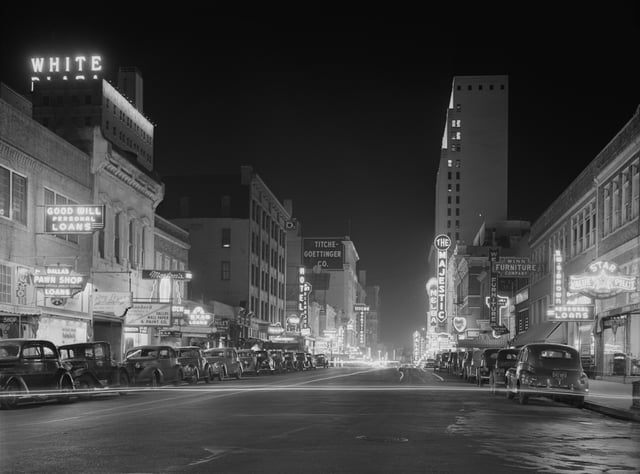
Elm Street at night, January 1942
Central Dallas is anchored by Downtown, the center of the city, along with Oak Lawn and Uptown, areas characterized by dense retail, restaurants, and nightlife. Downtown Dallas has a variety of named districts, including the West End Historic District, the Arts District, the Main Street District, Farmers Market District, the City Center Business District, the Convention Center District, and the Reunion District. "Hot spots" in this area include Uptown, Victory Park, Harwood, Oak Lawn, Dallas Design District, Trinity Groves, Turtle Creek, Cityplace, Knox/Henderson, Greenville, and West Village.
East Dallas
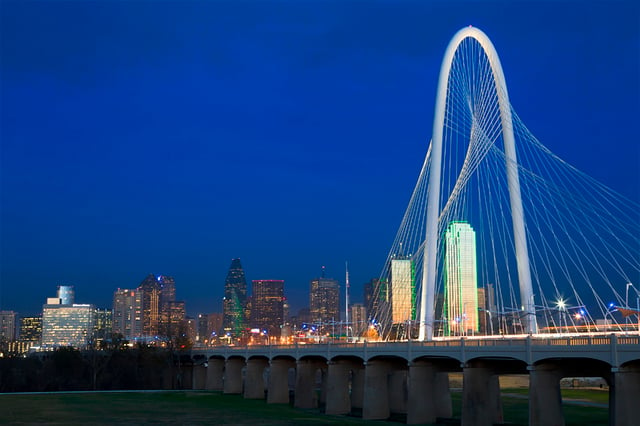
Named after Dallas philanthropist, the Margaret Hunt Hill Bridge spans the Trinity River
East Dallas is home to Deep Ellum, a trendy arts area close to Downtown, the homey Lakewood neighborhood (and adjacent areas, including Lakewood Heights, Wilshire Heights, Lower Greenville, Junius Heights, and Hollywood Heights/Santa Monica), historic Vickery Place and Bryan Place, and the architecturally significant neighborhoods of Swiss Avenue and Munger Place. Its historic district has one of the largest collections of Frank Lloyd Wright-inspired prairie-style homes in the United States. In the northeast quadrant of the city is Lake Highlands, one of Dallas's most unified middle-class neighborhoods.[36]
South Dallas

View of Downtown Dallas
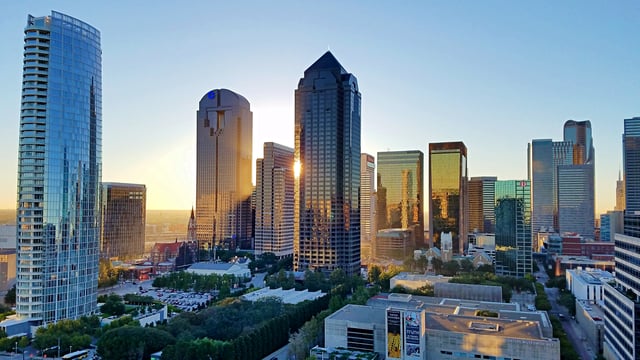
Dallas Arts District
South Dallas, a distinct neighborhood southeast of Downtown, lays claim to the Cedars, an eclectic artist hotbed, and Fair Park, home of the annual State Fair of Texas, held from late September through mid-October.[37] Southwest of Downtown lies Oak Cliff, a hilly area that has undergone gentrification in recent years, in neighborhoods such as the Bishop Arts District. Oak Cliff was a township founded in the mid-1800s and annexed in 1903 by Dallas.[38] Today, most of the area's northern residents are Hispanic and Latin American. The ghost town of La Reunion once occupied the north tip of Oak Cliff. South Oak Cliff's population is a mix of African American, Hispanic, and Native American.
South Side Dallas is a popular location for nightly entertainment at the NYLO rooftop patio and lounge,[39] The Cedars Social.[40] The neighborhood has undergone extensive development and community integration. What was once an area characterized by high rates of poverty and crime is now one of the city's most attractive social and living destinations.[41]
Further east, in the southeast quadrant of the city, is the large neighborhood of Pleasant Grove. Once an independent city, it is a collection of mostly lower-income residential areas stretching to Seagoville in the southeast. Though a city neighborhood, Pleasant Grove is surrounded by undeveloped land on all sides. Swampland and wetlands separating it from South Dallas are part of the Great Trinity Forest,[42] a subsection of the city's Trinity River Project, newly appreciated for habitat and flood control.
Districts
Bishop Arts District
Casa Linda
Casa View
Cedars, The
Deep Ellum
Design District
Downtown
Exposition Park
Fair Park
Highland Hills
Kessler Park
Knox-Henderson
Lakewood
Lake Highlands
Lower Greenville
"M" Streets
Oak Cliff
Oak Lawn
Park Cities
Pleasant Grove
Preston Hollow
Southwestern Medical District
Trinity Groves
Turtle Creek
Uptown
Victory Park
West End
Topography
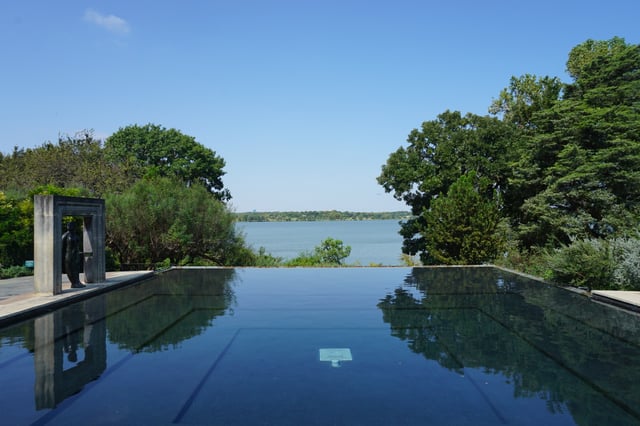
Dallas Arboretum and Botanical Garden
Dallas and its surrounding area are mostly flat; the city lies at elevations ranging from 450 to 550 feet (137 to 168 m) above sea level. The western edge of the Austin Chalk Formation, a limestone escarpment (also known as the "White Rock Escarpment"), rises 230 feet (70 m) and runs roughly north-south through Dallas County. South of the Trinity River, the uplift is particularly noticeable in the neighborhoods of Oak Cliff and the adjacent cities of Cockrell Hill, Cedar Hill, Grand Prairie, and Irving. Marked variations in terrain are also found in cities immediately to the west in Tarrant County surrounding Fort Worth, as well as along Turtle Creek north of Downtown.
Dallas, like many other cities, was founded along a river. The city was founded at the location of a "white rock crossing" of the Trinity River, where it was easier for wagons to cross the river in the days before ferries or bridges. The Trinity River, though not usefully navigable, is the major waterway through the city. Interstate 35E parallels its path through Dallas along the Stemmons Corridor, then south alongside the western portion of Downtown and past South Dallas and Pleasant Grove, where the river is paralleled by Interstate 45 until it exits the city and heads southeast towards Houston. The river is flanked on both sides by 50 feet (15 m) tall earthen levees to protect the city from frequent floods.[43]
Since it was rerouted in the late 1920s, the river has been little more than a drainage ditch within a floodplain for several miles above and below Downtown, with a more normal course further upstream and downstream, but as Dallas began shifting towards postindustrial society, public outcry about the lack of aesthetic and recreational use of the river ultimately gave way to the Trinity River Project,[44] which was begun in the early 2000s.
The project area reaches for over 20 miles (32 km) in length within the city, while the overall geographical land area addressed by the Land Use Plan is approximately 44,000 acres (180 km2) in size—about 20% of the land area in Dallas. Green space along the river encompasses approximately 10,000 acres (40 km2), making it one of the largest and diverse urban parks in the world.[45]
White Rock Lake, a reservoir built at the beginning of the 20th century, is Dallas's other significant water feature. The lake and surrounding park is a popular destination for boaters, rowers, joggers, and bikers, as well as visitors seeking peaceful respite from the city at the 66-acre (267,000 m2) Dallas Arboretum and Botanical Garden, on the lake's eastern shore. White Rock Creek feeds into White Rock Lake, and then exits on to the Trinity River southeast of Downtown Dallas. Trails along White Rock Creek are part of the extensive Dallas County Trails System.
Bachman Lake, just northwest of Love Field Airport, is a smaller lake also popularly used for recreation. Northeast of the city is Lake Ray Hubbard, a vast 22,745-acre (92 km2) reservoir in an extension of Dallas surrounded by the suburbs of Garland, Rowlett, Rockwall, and Sunnyvale.[46] To the west of the city is Mountain Creek Lake, once home to the Naval Air Station Dallas (Hensley Field) and a number of defense aircraft manufacturers.[47] North Lake, a small body of water in an extension of the city limits surrounded by Irving and Coppell, initially served as a water source for a nearby power plant but is now being targeted for redevelopment as a recreational lake due to its proximity to Dallas/Fort Worth International Airport, a plan the lake's neighboring cities oppose.[48]
Climate
Dallas has a humid subtropical climate (Köppen climate classification: Cfa) characteristic of the Southern Plains of the United States. It is also continental, characterized by a relatively wide annual temperature range. Located at the lower end of Tornado Alley, it is prone to extreme weather, tornadoes, and hailstorms.
Summers in Dallas are very hot and humid. July and August are typically the hottest months, with an average high of 96.0 °F (36 °C) and an average low of 76.7 °F (25 °C). Heat indices regularly surpass 105 °F (41 °C) at the height of summer. The all-time record high is 113 °F (45 °C), set on June 26 and 27, 1980 during the Heat Wave of 1980 at nearby Dallas/Fort Worth International Airport.[49][50]
Winters in Dallas are cool to mild, with occasional cold spells. The average date of first frost is November 12, and the average date of last frost is March 12.[51] January is typically the coldest month, with an average daytime high of 56.8 °F (14 °C) and an average nighttime low of 37.3 °F (3 °C). The normal daily average temperature in January is 47.0 °F (8 °C) but sharp swings in temperature can occur, as strong cold fronts known as "Blue Northers" pass through the Dallas region, forcing daytime highs below the 50 °F (10 °C) mark for several days at a time and often between days with high temperatures above 80 °F (27 °C). Snow accumulation is seen in the city in about 70% of winter seasons, and snowfall generally occurs 1–2 days out of the year for a seasonal average of 1.5 inches (4 cm). Some areas in the region, however, receive more than that, while other areas receive negligible snowfall or none at all.[52] The all-time record low temperature within the city is −3 °F (−19 °C), set on January 18, 1930.
Spring and autumn are transitional seasons with moderate and pleasant weather. Vibrant wildflowers (such as the bluebonnet, Indian paintbrush and other flora) bloom in spring and are planted around the highways throughout Texas.[53] Springtime weather can be quite volatile, but temperatures themselves are mild. The weather in Dallas is also generally pleasant from late September to early December and on many winter days. Autumn often brings more storms and tornado threats, but they are usually fewer and less severe than in spring.
Each spring, cold fronts moving south from the North will collide with warm, humid air streaming in from the Gulf Coast, leading to severe thunderstorms with lightning, torrents of rain, hail, and occasionally, tornadoes. Over time, tornadoes have probably been the most significant natural threat to the city, as it is near the heart of Tornado Alley.
A few times each winter in Dallas, warm and humid air from the south will override cold, dry air, resulting in freezing rain or ice and causing disruptions in the city if the roads and highways become slick. Temperatures reaching 70 °F (21 °C) on average occur on at least four days each winter month. Dallas averages 26 annual nights at or below freezing,[49] with the winter of 1999–2000 holding the record for the fewest freezing nights with 14. During this same span of 15 years, the temperature in the region has only twice dropped below 15 °F (−9 °C), though it will generally fall below 20 °F (−7 °C) in most (67%) years.[49]
The U.S. Department of Agriculture places Dallas in Plant Hardiness Zone 8a.[54][55] However, mild winter temperatures in the past 15 to 20 years have encouraged the horticulture of some cold-sensitive plants such as Washingtonia filifera and Washingtonia robusta palms. According to the American Lung Association, Dallas has the 12th highest air pollution among U.S. cities, ranking it behind Los Angeles and Houston.[56] Much of the air pollution in Dallas and the surrounding area comes from a hazardous materials incineration plant in the small town of Midlothian and from concrete installations in neighboring Ellis County.[57]
The average daily low in Dallas is 57.4 °F (14 °C), and the average daily high is 76.9 °F (25 °C). Dallas receives approximately 37.6 inches (955 mm) of rain per year. The record snowfall for Dallas was 11.2 inches (28 cm) on February 11, 2010.
| Climate data for Dallas (Love Field), 1981–2010 normals,[2] extremes 1913–present[3] | |||||||||||||
|---|---|---|---|---|---|---|---|---|---|---|---|---|---|
| Month | Jan | Feb | Mar | Apr | May | Jun | Jul | Aug | Sep | Oct | Nov | Dec | Year |
| Record high °F (°C) | 88 (31) | 95 (35) | 97 (36) | 100 (38) | 103 (39) | 112 (44) | 112 (44) | 111 (44) | 110 (43) | 100 (38) | 92 (33) | 89 (32) | 112 (44) |
| Mean maximum °F (°C) | 76.4 (24.7) | 80.2 (26.8) | 85.6 (29.8) | 89.4 (31.9) | 95.2 (35.1) | 98.2 (36.8) | 103.0 (39.4) | 103.9 (39.9) | 98.8 (37.1) | 92.3 (33.5) | 82.9 (28.3) | 76.8 (24.9) | 105.0 (40.6) |
| Average high °F (°C) | 56.8 (13.8) | 60.8 (16.0) | 68.7 (20.4) | 76.7 (24.8) | 84.2 (29.0) | 91.6 (33.1) | 96.0 (35.6) | 96.4 (35.8) | 88.7 (31.5) | 78.5 (25.8) | 67.1 (19.5) | 57.5 (14.2) | 77.0 (25.0) |
| Average low °F (°C) | 37.3 (2.9) | 41.1 (5.1) | 48.5 (9.2) | 56.2 (13.4) | 65.4 (18.6) | 72.8 (22.7) | 76.7 (24.8) | 76.8 (24.9) | 69.0 (20.6) | 58.2 (14.6) | 47.6 (8.7) | 38.5 (3.6) | 57.4 (14.1) |
| Mean minimum °F (°C) | 21.7 (−5.7) | 24.3 (−4.3) | 30.5 (−0.8) | 40.2 (4.6) | 52.1 (11.2) | 63.0 (17.2) | 69.7 (20.9) | 68.5 (20.3) | 53.8 (12.1) | 42.3 (5.7) | 31.3 (−0.4) | 22.9 (−5.1) | 16.7 (−8.5) |
| Record low °F (°C) | −3 (−19) | 2 (−17) | 11 (−12) | 30 (−1) | 39 (4) | 53 (12) | 56 (13) | 57 (14) | 36 (2) | 26 (−3) | 17 (−8) | 1 (−17) | −3 (−19) |
| Average precipitation inches (mm) | 2.06 (52) | 2.59 (66) | 3.49 (89) | 3.07 (78) | 4.92 (125) | 4.11 (104) | 2.21 (56) | 1.87 (47) | 2.84 (72) | 4.79 (122) | 2.88 (73) | 2.74 (70) | 37.57 (954) |
| Average snowfall inches (cm) | 0.5 (1.3) | 0.6 (1.5) | 0.1 (0.25) | 0 (0) | 0 (0) | 0 (0) | 0 (0) | 0 (0) | 0 (0) | 0 (0) | trace | 0.3 (0.76) | 1.5 (3.8) |
| Average precipitation days(≥ 0.01 in) | 6.7 | 6.5 | 7.6 | 6.7 | 9.7 | 8.0 | 4.9 | 4.6 | 5.3 | 7.5 | 6.6 | 6.6 | 80.7 |
| Average snowy days(≥ 0.1 in) | 0.5 | 0.2 | 0.2 | 0 | 0 | 0 | 0 | 0 | 0 | 0 | 0.1 | 0.3 | 1.3 |
| Average relative humidity (%) | 67.5 | 66.4 | 63.7 | 65.3 | 69.7 | 65.8 | 59.8 | 59.5 | 66.5 | 65.7 | 67.4 | 67.5 | 65.4 |
| Mean monthly sunshine hours | 183.5 | 178.3 | 227.7 | 236.0 | 258.4 | 297.8 | 332.4 | 304.5 | 246.2 | 228.1 | 183.8 | 173.0 | 2,849.7 |
| Percent possible sunshine | 58 | 58 | 61 | 61 | 60 | 69 | 76 | 74 | 66 | 65 | 59 | 56 | 64 |
| Source: NOAA (sun and relative humidity 1961–1990 at DFW Airport)[4][59][60][61] | |||||||||||||
Demographics
| Historical population | |||
|---|---|---|---|
| Census | Pop. | %± | |
| 1850 | 1,073 | — | |
| 1860 | 698 | −34.9% | |
| 1870 | 3,000 | 329.8% | |
| 1880 | 10,358 | 245.3% | |
| 1890 | 38,069 | 267.5% | |
| 1900 | 42,639 | 12.0% | |
| 1910 | 92,104 | 116.0% | |
| 1920 | 158,976 | 72.6% | |
| 1930 | 269,475 | 69.5% | |
| 1940 | 294,734 | 9.4% | |
| 1950 | 434,462 | 47.4% | |
| 1960 | 679,684 | 56.4% | |
| 1970 | 844,401 | 24.2% | |
| 1980 | 904,078 | 7.1% | |
| 1990 | 1,006,977 | 11.4% | |
| 2000 | 1,188,580 | 18.0% | |
| 2010 | 1,197,816 | 0.8% | |
| Est. 2018 | 1,345,047 | [13] | 12.3% |
| Source:[62][63][64] | |||
Dallas is the ninth most-populous city in the United States[14] and third in Texas after the cities of Houston and San Antonio. Its metropolitan area encompasses one-quarter of the population of Texas, and is the largest in the Southern U.S. and Texas followed by the Greater Houston metropolitan area. In July 2018, the population estimate of the city of Dallas was 1,345,047, an increase of 147,231 since the 2010 United States Census.[13]
There were 552,711 households at the 2017 estimates,[65] up from 2010's 458,057 households, out of which 29.1% had children under the age of 18 living with them. In 2010, 36.1% were headed by married couples living together, 16.0% had a female householder with no husband present, and 42.0% were classified as non-family households. 33.7% of all households had one or more people under 18 years of age, and 17.6% had one or more people who were 65 years of age or older. The average household size was 2.57 and the average family size was 3.42.[66] As of 2017 the owner-occupied housing unit rate was 41.5%.[67]
At the 2010 census, the city's age distribution of the population showed 26.5% under the age of 18 and 8.8% who were 65 years of age or older. The median age was 31.8 years. 50.0% of the population was male and 50.0% was female.[66]
According to the 2017 American Community Survey, the median income for a household in the city was $47,285.[67] In 2003-2007's survey, male full-time workers had a median income of $32,265 versus $32,402 for female full-time workers. The per capita income for the city was $25,904. About 18.7% of families and 21.7% of the population were below the poverty line, including 33.6% of those under age 18 and 13.4% of those aged 65 or over. Per 2007's survey, the median price for a house was $129,600.[68]
Race and ethnicity
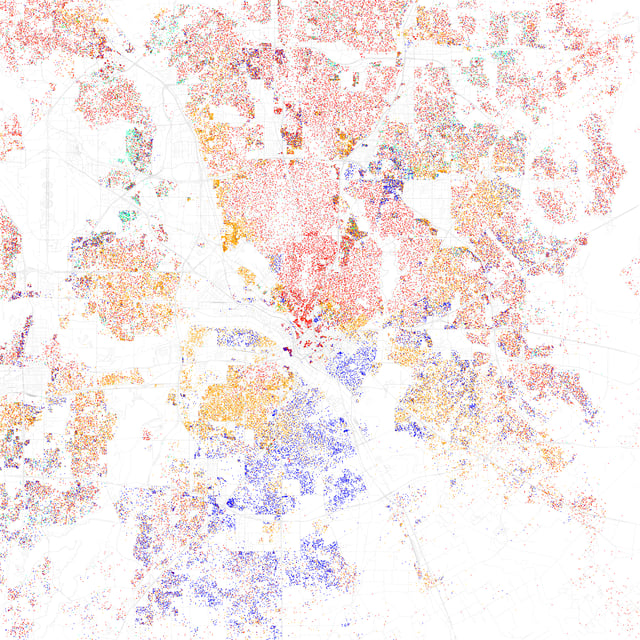
Map of racial distribution in Dallas, 2010 U.S. Census. Each dot is 25 people: White, Black, Asian Hispanic, or Other (yellow)

Trilingual sign on shop in multilingual neighborhood: English, Spanish, Amharic
| Racial composition | 2010[69] | 1990[70] | 1970[70] | 1950[70] |
|---|---|---|---|---|
| White or European American | 50.7% | 55.3% | 74.2% | 86.8% |
| —Non-Hispanic | 28.8% | 47.7% | 66.9%[71] | n/a |
| Black or African American | 24.7% | 29.5% | 24.9% | 13.1% |
| Hispanic or Latino (of any race) | 42.4% | 20.9% | 7.5%[71] | n/a |
| Asian | 2.9% | 2.2% | 0.2% | – |
Dallas's population was historically predominantly white (non-Hispanic whites made up 82.8% of the population in 1930),[70] but its population has diversified due to immigration and white flight over the 20th century. Today the non-Hispanic white population has declined to less than one-third of the city's population.[72]
According to the 2010 census, 50.7% of the population was White (28.8% non-Hispanic white), 24.8% was Black or African American, 0.7% American Indian and Alaska Native, 2.9% Asian, and 2.6% from two or more races. 42.4% of the total population was of Hispanic or Latino origin (they may be of any race).[73] In the United States Census Bureau's 2017 estimates, 61.8% was White (29.1% non-Hispanic white), 24.3% Black or African American, 0.3% American Indian or Alaska Native, 3.4% Asian, and 2.6% from two or more races. Native Hawaiian and Other Pacific Islanders make up a total of 606 residents according to 2017's estimates.[17] Hispanics or Latinos of any race made up 41.7% of the estimated population.
At the 2006–2010 American Community Survey 5-Year Estimates, among the Hispanic or Latin American population, 36.8% of Dallas was Mexican, 0.3% Puerto Rican, 0.2% Cuban and 4.3% other Hispanic or Latino.[74][75][76] In 2017's American Community Survey estimates among the demographic 36% were Mexican, 0.5% Puerto Rican, 0.3% Cuban, and 4.9% other Hispanic or Latino.[17]
Dallas is a major destination for Mexican immigrants. The southwestern portion of the city, particularly Oak Cliff is chiefly inhabited by Hispanic and Latin American residents. The southeastern portion of the city Pleasant Grove is chiefly inhabited by African American and Hispanic or Latino residents, while the southern portion of the city is predominantly black. The west and east sides of the city are predominantly Hispanic or Latino; Garland also has a large Spanish speaking population. North Dallas has many enclaves of predominantly white, black and especially Hispanic or Latino residents.
The Dallas–Fort-Worth metro has an estimated 70,000 Russian-speakers (as of November 6, 2012) mostly immigrants from the former Soviet Bloc.[77] Included in this population are Russians, Russian Jews, Ukrainians, Belarusians, Moldavians, Uzbek, Kirghiz, and others. The Russian-speaking population of Dallas has continued to grow in the sector of "American husbands-Russian wives". Russian DFW has its own newspaper, The Dallas Telegraph.
In addition, Dallas and its suburbs are home to a large number of Asian Americans[78] including those of Indian, Vietnamese, Chinese, Korean, Filipino, Japanese, and other heritage.[79] Among large-sized cities in the United States, Plano, the northern suburb of Dallas, has the 6th largest Chinese-American population. The Plano-Richardson area in particular has an estimated 30,000 Iranian-Americans.[80][81]
There are also a significant number of people from the Horn of Africa, immigrants from Ethiopia, Eritrea and Somalia. With so many immigrant groups, there are often multilingual signs in the linguistic landscape.
According to U.S. Census American Community Survey data released in December 2013, 23 percent of Dallas County residents were foreign-born, while 16 percent of Tarrant County residents were foreign-born.[82]
Sexual orientation and gender identity
Recognized for having one of the largest lesbian, gay, bisexual, and transgender (LGBT) populations in the nation, the metroplex is widely noted for being home to a thriving and diverse LGBT community.[22] Throughout the year there are many well-established LGBT events held in the area, most notably the annual Alan Ross Texas Freedom (Pride) Parade and Festival in June which draws approximately 50,000.[83][84] For decades, the Oak Lawn and Bishop Arts districts have been known as the epicenters of the LGBT community in Dallas.[85]
Religion
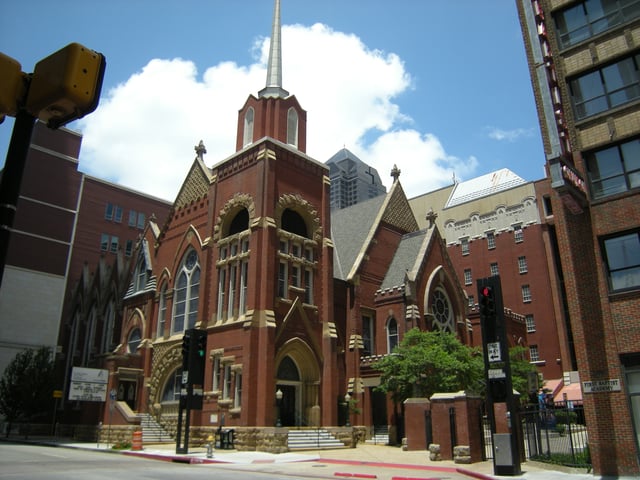
First Baptist Church Dallas
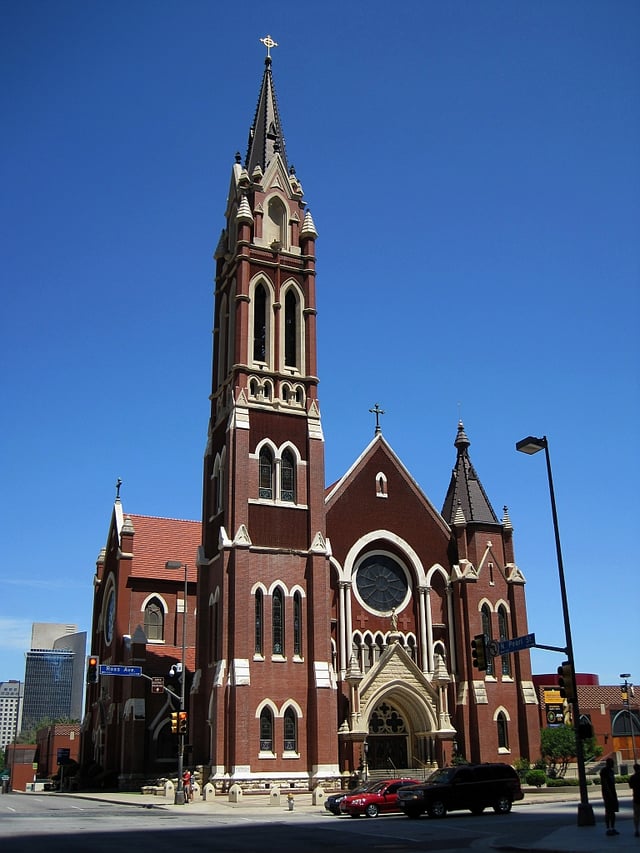
Cathedral Santuario de la Virgen de Guadalupe

Saint Seraphim Cathedral
Christianity is the most prevalently practiced religion in Dallas and the wider metropolitan area according to a 2014 study by the Pew Research Center (78%).[86][87] There is a large Protestant Christian influence in the Dallas community. Methodist, Baptist, and Presbyterian churches are prominent in many neighborhoods and anchor two of the city's major private universities (Southern Methodist University and Dallas Baptist University). Dallas is also home to two evangelical seminaries: the Dallas Theological Seminary and Criswell College. Many Bible schools including Christ For The Nations Institute are also headquartered in the city. The Christian creationist apologetics group Institute for Creation Research is headquartered in Dallas.
Dallas is called "Prison Ministry Capital of the World" by the prison ministry community. It is a home for the International Network of Prison Ministries, the Coalition of Prison Evangelists, Bill Glass Champions for Life, Chaplain Ray's International Prison Ministry, and 60 other prison ministries.[88]
The Catholic Church is also a significant organization in the Dallas area and operates the University of Dallas, a liberal-arts university in the Dallas suburb of Irving. The Cathedral Santuario de la Virgen de Guadalupe in the Arts District is home to the second-largest Catholic church membership in the United States and overseas,[89] consisting over 70 parishes in the Dallas Diocese. The Society of Jesus operates the Jesuit College Preparatory School of Dallas. Dallas is also home to numerous Eastern Orthodox and Oriental Orthodox churches.[90] The city of Dallas and Dallas County have more Catholic than Protestant residents, while the converse is usually true for the suburban areas of Dallas and the city of Fort Worth.
The city is also home to a sizable Latter-day Saint community. The Church of Jesus Christ of Latter-day Saints has twenty-three stakes throughout Dallas and surrounding suburbs.[91] The organization built the Dallas Texas Temple, the first temple in Texas, in the city in 1984.[92] Jehovah's Witnesses also have a large number of members throughout Dallas and surrounding suburbs. In addition, there are several Unitarian Universalist congregations, including First Unitarian Church of Dallas, founded in 1899.[93] A large community of the United Church of Christ exists in the city. The most prominent UCC-affiliated church is the Cathedral of Hope, a predominantly LGBT-affirming church.
Dallas's Jewish population of approximately 45,000 is the largest of any city in Texas.[94] Since the establishment of the city's first Jewish cemetery in 1854 and its first congregation (which would eventually be known as Temple Emanu-El) in 1873, Dallasite Jews have been well represented among leaders in commerce, politics, and various professional fields in Dallas and elsewhere.
Furthermore, a large Muslim community exists in the north and northeastern portions of Dallas, as well as in the northern Dallas suburbs. The oldest mosque in Texas is in Denton, about 40 miles (64 km) north of Downtown Dallas. The oldest mosque in Dallas is Masjid Al-Islam just south of Downtown. There is also a Sunni Islamic Center in Irving.
Dallas also has a large Buddhist community. Immigrants from East Asia, Southeast Asia, Nepal, and Sri Lanka have all contributed to the Buddhist population, which is concentrated in the northern suburbs of Garland, Plano and Richardson. Numerous Buddhist temples dot the metroplex including The Buddhist Center of Dallas, Lien Hoa Vietnamese Temple of Irving, and Kadampa Meditation Center Texas and Wat Buddhamahamunee of Arlington.
The Winter Solstice Celebration is held in the metroplex for "spiritual but not religious" people although some of its participants are also neo-pagans and New Agers.[98]
Crime
According to the FBI, a city to city comparison of crime rates is not meaningful, because recording practices vary from city to city, citizens report different percentages of crimes from one city to the next, and the actual number of people physically present in a city is unknown.[99] With that in mind, Dallas's violent crime rate (12.06 per 1,000 people) is lower than St Louis (24.81), Detroit (24.22), Baltimore (16.96), Philadelphia (15.62), Cleveland (15.47), Miami (15.09), Washington, D.C. (14.48), Kansas City (14.44) and Boston (13.39). However, Houston (11.69), Los Angeles (7.87), and New York City (6.38) have lower violent crime rates than Dallas.[100]
Economy
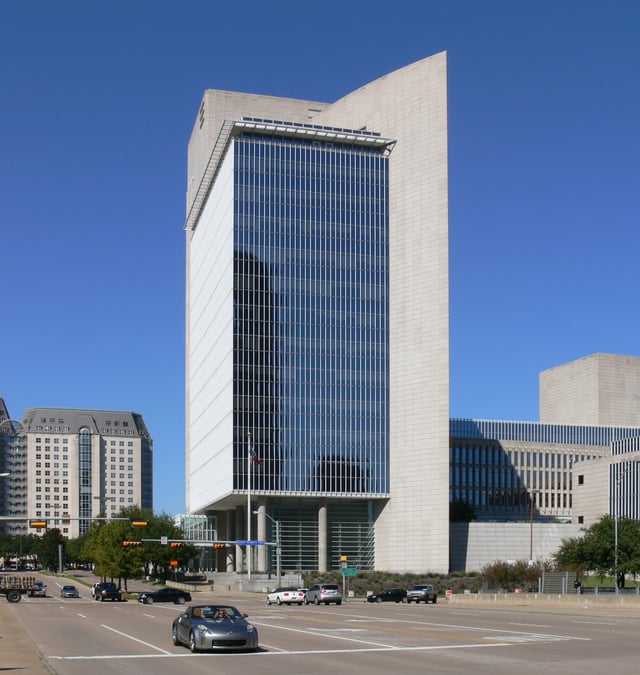
Federal Reserve Bank of Dallas
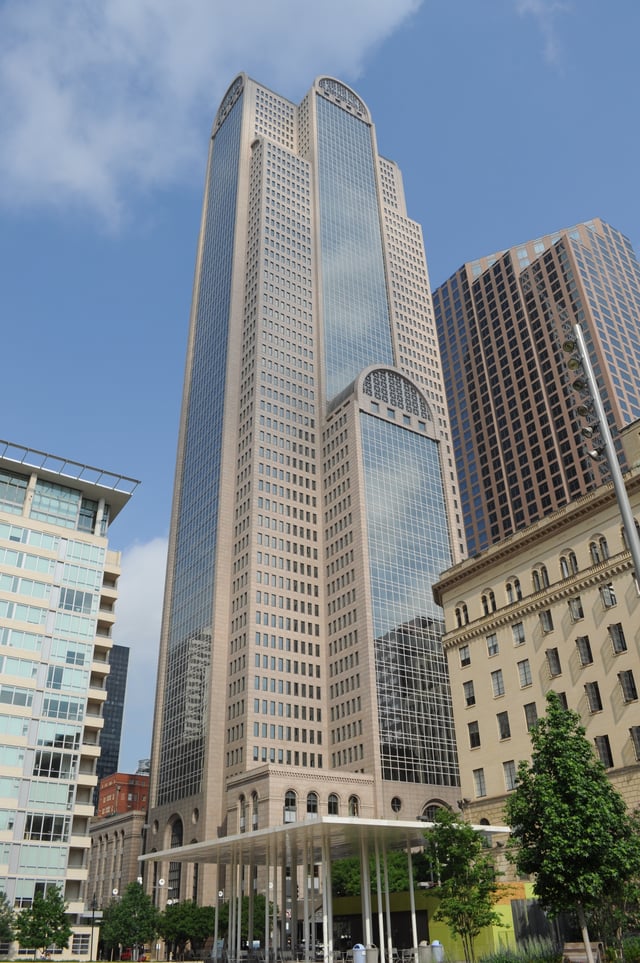
Comerica Bank Tower
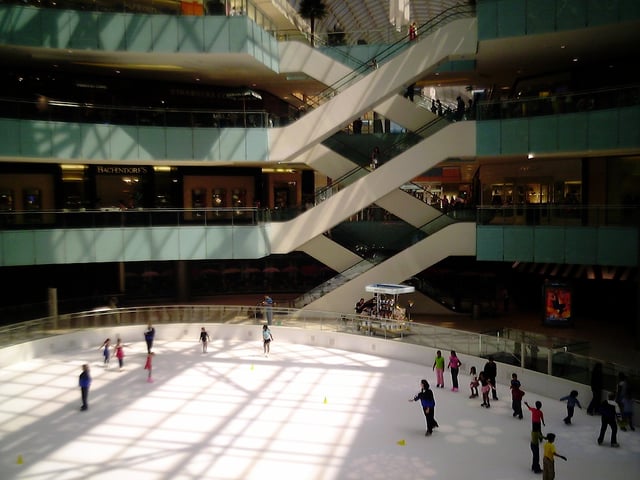
Ice rink at the Dallas Galleria, 2006
| **Top publicly traded companies in Dallas for 2017** according to revenues with Dallas and U.S. ranks. | |||||
| DAL | Corporation | US | |||
| 1 | AT&T | 9 | |||
| 2 | Energy Transfer Equity | 79 | |||
| 3 | Tenet Healthcare | 134 | |||
| 4 | Southwest Airlines | 138 | |||
| 5 | Texas Instruments | 206 | |||
| 6 | Jacobs Engineering | 259 | |||
| 7 | HollyFrontier Corporation | 274 | |||
| 8 | Dean Foods | 351 | |||
| 9 | Builders FirstSource | 421 | |||
| Further information: List of companies in Dallas/Ft.Worth Source:: Dallas Morning News[101] | |||||
In its beginnings, Dallas relied on farming, neighboring Fort Worth's Stockyards, and its prime location on Native American trade routes to sustain itself. Dallas' key to growth came in 1873 with the construction of multiple rail lines through the city. As Dallas grew and technology developed, cotton became its boon and by 1900, Dallas was the largest inland cotton market in the world, becoming a leader in cotton gin machinery manufacturing.
By the early 1900s, Dallas was a hub for economic activity all over the Southern United States and was selected in 1914 as the seat of the Eleventh Federal Reserve District. By 1925, Texas churned out more than ⅓ of the nation's cotton crop, with 31% of Texas cotton produced within a 100-mile (160 km) radius of Dallas. In the 1930s, petroleum was discovered east of Dallas, near Kilgore. Dallas' proximity to the discovery put it immediately at the center of the nation's petroleum market. Petroleum discoveries in the Permian Basin, the Panhandle, the Gulf Coast, and Oklahoma in the following years further solidified Dallas' position as the hub of the market.[102]
The end of World War II left Dallas seeded with a nexus of communications, engineering, and production talent by companies such as Collins Radio Corporation. Decades later, the telecommunications and information revolutions still drive a large portion of the local economy. The city is sometimes referred to as the heart of "Silicon Prairie" because of a high concentration of telecommunications companies in the region, the epicenter of which lies along the Telecom Corridor in Richardson, a northern suburb of Dallas. The Corridor is home to more than 5,700 companies[103] including Texas Instruments (headquartered in Dallas), Nortel Networks, Alcatel Lucent, AT&T, Ericsson, Fujitsu, Nokia, Rockwell Collins, Cisco Systems, Sprint, Verizon Communications, XO Communications and until recently CompUSA (which is now headquartered in Miami, Florida). Texas Instruments, a major manufacturer, employs 10,400 people at its corporate headquarters and chip plants in Dallas.[104]
In the 1980s Dallas was a real estate hotbed, with the increasing metropolitan population bringing with it a demand for new housing and office space. Several of Downtown Dallas' largest buildings are the fruit of this boom, but over-speculation, the savings and loan crisis and an oil bust brought the 80's building boom to an end for Dallas as well as its sister city Houston. Between the late 1980s and the early 2000s, central Dallas went through a slow period of growth. However, since the early 2000s the central core of Dallas has been enjoying steady and significant growth encompassing both repurposing of older commercial buildings in Downtown Dallas into residential and hotel uses, as well as the construction of new office and residential towers. The opening of Klyde Warren Park, built across Woodall Rodgers Freeway seamlessly connecting the central Dallas CBD to Uptown/Victory Park, has acted synergistically with the highly successful Dallas Arts District, so both have become catalysts for significant new development in central Dallas.
The residential real estate market in the Dallas–Fort Worth metroplex has not only been resilient but has once again returned to a boom status. Dallas and the greater metro area have been leading the nation in apartment construction and net leasing, with rents reaching all-time highs. Single family home sales, whether pre-owned or new construction, along with home price appreciation, were leading the nation since 2015.[105][106]
A sudden drop in the price of oil, starting in mid-2014 and accelerating throughout 2015, has not significantly affected Dallas and its greater metro area due to the highly diversified nature of its economy. Dallas, and the DFW metro, continue to see strong demand for housing, apartment and office leasing, shopping center space, warehouse and industrial space with overall job growth remaining very robust. Oil-dependent cities and regions have felt significant effects from the downturn, but Dallas's growth has continued unabated, strengthening in 2015. Significant national headquarters relocations to the area (as exemplified by Toyota's decision to leave California and establish its new North American headquarters in the Dallas area) coupled with significant expansions of regional offices for a variety of corporations and along with company relocations to Downtown Dallas helped drive the boom in the Dallas economy. Dallas led Texas's largest cities in Forbes magazine's 2015 ranking of "The Best Place for Business and Careers".[107]
The Dallas–Fort Worth area has one of the largest concentrations of corporate headquarters for publicly traded companies in the United States. Fortune Magazine's 2017 annual list of the Fortune 500 in America indicates the city of Dallas has 9 Fortune 500 companies,[108] and the DFW region as a whole has 22,[101] reflecting the continued strong growth in the metro economy and up from 20 the year before.[109] Dallas–Fort Worth now represents the largest concentration of Fortune 500 headquarters in Texas, followed by Greater Houston with its count of 20, down from 24 the year before.[110]
In 2008, AT&T relocated their headquarters to Downtown Dallas;[111] AT&T is the largest telecommunications company in the world[112] and was the ninth largest company in the nation by revenue for 2017. Additional Fortune 500 companies headquartered in Dallas in order of ranking include Energy Transfer Equity, Tenet Healthcare, Southwest Airlines, Texas Instruments, Jacobs Engineering, HollyFrontier, Dean Foods, and Builders FirstSource. In October 2016, Jacobs Engineering, one of the world's largest engineering companies, relocated from Pasadena, California to Downtown Dallas.[113]
Irving is home to six Fortune 500 companies of its own, including ExxonMobil, the largest oil company in the world[114] and the fourth largest company in the nation by revenue for 2017,[108] Fluor (engineering), Kimberly-Clark, Celanese, Michaels Companies, and Vistra Energy.[108] Plano is home to four Fortune 500 companies, including J.C. Penney, Alliance Data Systems, Yum China Holdings, and Dr. Pepper Snapple.[108] Fort Worth is home to two Fortune 500 companies, including American Airlines, the largest airline in the world by revenue, fleet size, profit, passengers carried and revenue passenger mile and D.R. Horton, the largest homebuilder in America.[108] One Fortune 500 company, Gamestop, is based in Grapevine.
Additional major companies headquartered in Dallas and its metro area include Comerica, which relocated its national headquarters to Downtown Dallas from Detroit in 2007,[115] NTT DATA Services, Regency Energy Partners, Atmos Energy, Neiman Marcus, Think Finance, 7-Eleven, Brinker International, Primoris Services, AMS Pictures, id Software, Mary Kay Cosmetics, Chuck E. Cheese's, Zale Corporation, and Fossil, Inc. Many of these companies—and others throughout the DFW metroplex—comprise the Dallas Regional Chamber.
Susan G. Komen for the Cure, the world's largest breast cancer organization[116] was founded and is headquartered in Dallas.
In addition to its large number of businesses, Dallas has more shopping centers per capita than any other city in the United States and is also home to the second shopping center ever built in the United States, Highland Park Village, which opened in 1931.[117] Dallas is home of the two other major malls in North Texas, the Dallas Galleria and NorthPark Center, which is the second largest mall in Texas. Both malls feature high-end stores and are major tourist draws for the region.[118][119]
According to Forbes magazine's annual list of "The Richest People in America" published September 21, 2011, the city is home to 17 billionaires, up from 14 in 2009. In 2009 (with 14 billionaires) the city placed sixth worldwide among cities with the most billionaires.[120][121] The ranking does not even take into account the eight billionaires who live in the neighboring city of Fort Worth. In 2013, Forbes also ranked Dallas No. 13 on its list of the "Best Places for Business and Careers".[122]
Dallas is the third most popular destination for business travel in the United States, and the Kay Bailey Hutchison Convention Center is one of the largest and busiest convention centers in the country, at over 1,000,000 square feet (93,000 m2), and the world's single-largest column-free exhibit hall.[123]
Arts and culture
Arts and museums

Perot Museum of Nature and Science in downtown Dallas

The Winspear Opera House
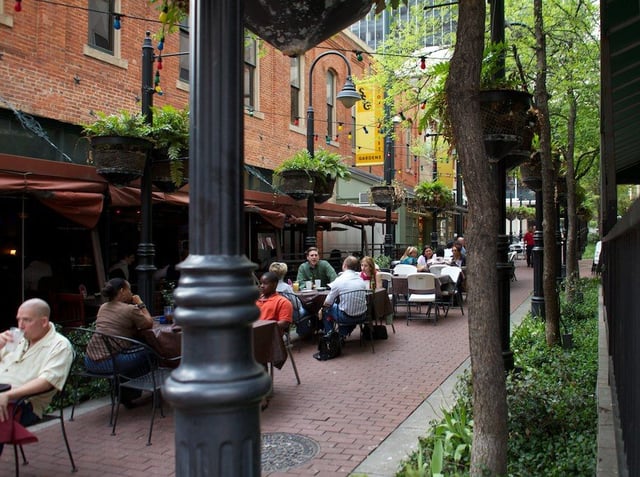
Stone Street Gardens is lined with bistros, pubs, and restaurants connecting Main to Elm Streets in Downtown Dallas.
The Arts District in the northern section of Downtown is home to several arts venues and is the largest contiguous arts district in the United States.[124] Notable venues in the district include the Dallas Museum of Art; the Morton H. Meyerson Symphony Center, home to the Dallas Symphony Orchestra and Dallas Wind Symphony; the Nasher Sculpture Center; and the Trammell & Margaret Crow Collection of Asian Art. The Perot Museum of Nature and Science, also in Downtown Dallas, is a natural history and science museum. Designed by 2005 Pritzker Architecture Prize Laureate Thom Mayne and his firm Morphosis Architects, the 180,000-square-foot facility has six floors and stands about 14 stories high.
Also, not far north of the area is the Meadows Museum at Southern Methodist University. In 2009, it joined up with Madrid's Prado Museum for a three-year partnership. The Prado focuses on Spanish visual art and has a collection of Spanish art in North America, with works by de Juanes, El Greco, Fortuny, Goya, Murillo, Picasso, Pkensa, Ribera, Rico, Velasquez, Zurbaran, and other Spaniards. These works, as well as non-Spanish highlights like sculptures by Rodin and Moore, have been so successful of a collaboration that the Prado and Meadows have agreed upon an extension of the partnership.[127]
The former Texas School Book Depository, from which, according to the Warren Commission Report, Lee Harvey Oswald shot and killed President John F. Kennedy in 1963, has served since the 1980s as a county government office building, except for its sixth and seventh floors, which house the Sixth Floor Museum.
The American Museum of the Miniature Arts is at the Hall of State in Fair Park.
The Arts District is also home to DISD's Booker T. Washington High School for the Performing and Visual Arts, a magnet school that was recently expanded.[128]
City Center District, next to the Arts District, is home to the Dallas Contemporary.
Deep Ellum, immediately east of Downtown, originally became popular during the 1920s and 1930s as the prime jazz and blues hot spot in the South.[129] Artists such as Blind Lemon Jefferson, Robert Johnson, Huddie "Lead Belly" Ledbetter, and Bessie Smith played in original Deep Ellum clubs such as the Harlem and the Palace. Today, Deep Ellum is home to hundreds of artists who live in lofts and operate in studios throughout the district alongside bars, pubs, and concert venues.[130] A major art infusion in the area results from the city's lax stance on graffiti, and a number of public spaces, including tunnels, sides of buildings, sidewalks, and streets, are covered in murals. One major example, the Good-Latimer tunnel, was torn down in late 2006 to accommodate the construction of a light rail line through the site.[131]
Like Deep Ellum before it, the Cedars neighborhood to the south of Downtown has also seen a growing population of studio artists and an expanding roster of entertainment venues. The area's art scene began to grow in the early 2000s with the opening of Southside on Lamar, an old Sears Roebuck and Company warehouse converted into lofts, studios, and retail. Within this building, Southside on Lamar hosts the Janette Kennedy Gallery with rotating gallery exhibitions featuring many local, national, and international artists.[132] Current attractions include Gilley's Dallas and Poor David's Pub.[133][134] Dallas Mavericks owner and local entrepreneur Mark Cuban purchased land along Lamar Avenue near Cedars Station in September 2005, and locals speculate he is planning an entertainment complex for the site.[135] South of the Trinity River, the Bishop Arts District in Oak Cliff is home to a number of studio artists living in converted warehouses. Walls of buildings along alleyways and streets are painted with murals, and the surrounding streets contain many eclectic restaurants and shops.[136]
Dallas has an Office of Cultural Affairs as a department of the city government. The office is responsible for six cultural centers throughout the city, funding for local artists and theaters, initiating public art projects, and running the city-owned classical radio station WRR.[137] The Los Angeles-class submarine USS Dallas was planned to become a museum ship near the Trinity River after her decommissioning in September 2014, but this has since been delayed.[138] It will be taken apart into massive sections in Houston and be transported by trucks to the museum site and will be put back together.
Libraries
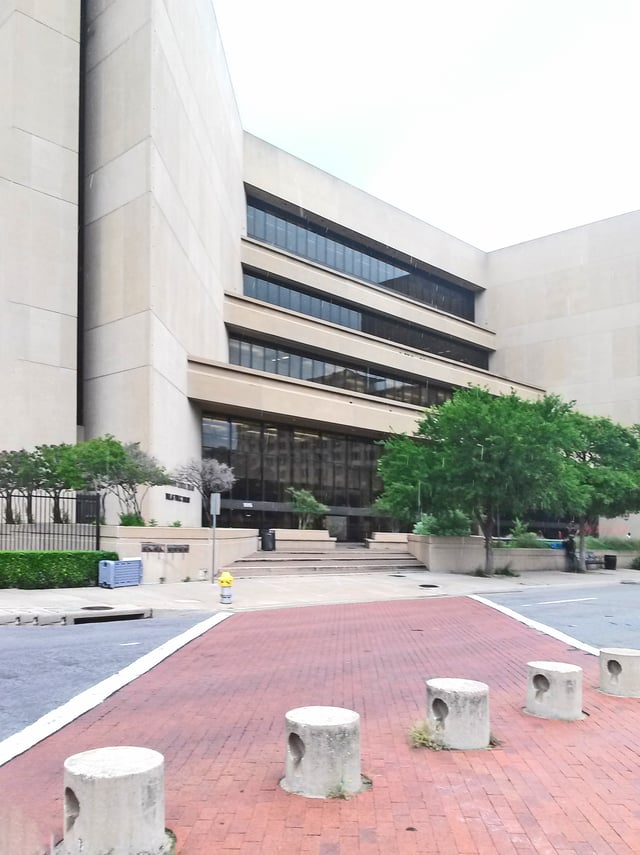
The J. Erik Jonsson Central Library in the Government District of Downtown Dallas
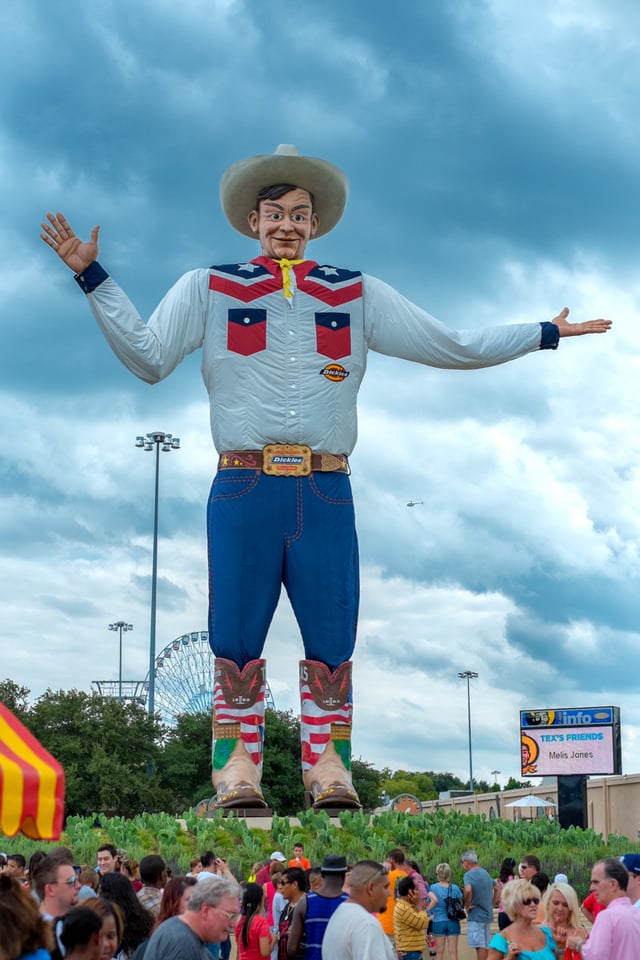
Big Tex, a statue at the Texas State Fair in Fair Park
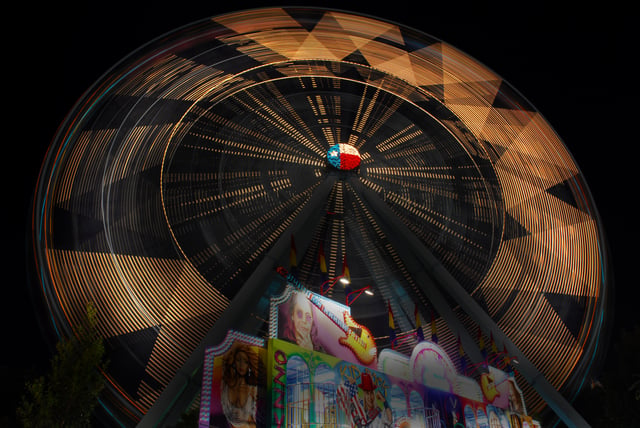
Texas Star ferris wheel spinning at night
The city is served by the Dallas Public Library system. The system was created by the Dallas Federation of Women's Clubs with efforts spearheaded by then president May Dickson Exall. Her fundraising efforts led to a grant from philanthropist and steel baron Andrew Carnegie, which allowed the library system to build its first branch in 1901.[139] Today, the library operates 29 branch locations throughout the city, including the 8-story J. Erik Jonsson Central Library in the Government District of Downtown.[140]
Places of interest
Adolphus Hotel
African American Museum
American Airlines Center
Arts District
Bishop Arts District
Cedars
Cotton Bowl
Dallas Arboretum and Botanical Garden
Dallas Baptist University
Dallas Hilton, the world's first modern Hilton
Dallas Holocaust Museum/Center for Education & Tolerance
Dallas Municipal Building
Dallas Museum of Art
Dallas World Aquarium
Dallas Zoo
Dealey Plaza
Dee and Charles Wyly Theatre
Design District
Fair Park
Farmers Market
Federal Reserve Bank of Dallas
Frontiers of Flight Museum
Galleria Dallas
George W. Bush Presidential Center
Highland Park Village
John Fitzgerald Kennedy Memorial
Kalita Humphreys Theater, designed by Frank Lloyd Wright
Katy Trail
Kirby Building
Klyde Warren Park
Majestic Theatre
Margaret Hunt Hill Bridge
Meadows Museum
Morton H. Meyerson Symphony Center
Munger Place Historic District
Museum of Biblical Art
The Nasher Sculpture Center
Neiman Marcus Building
NorthPark Center
Pioneer Plaza
Perot Museum of Nature and Science
Reunion Tower
Ronald Kirk Bridge
Sixth Floor Museum at Dealey Plaza
South Boulevard-Park Row Historic District
Southern Methodist University
Southfork Ranch as seen on Dallas (1978) and Dallas (2012)
Swiss Avenue historical district
Texas School Book Depository
Texas Theatre
Thanks-Giving Square
Trammell & Margaret Crow Collection of Asian Art
Trinity River Audubon Center
Victory Park
White Rock Lake
Events
The most notable event held in Dallas is the State Fair of Texas, which has been held annually at Fair Park since 1886. The fair is a massive event, bringing in an estimated $350 million to the city's economy annually.
The Red River Shootout, a football game that pits the University of Texas at Austin against the University of Oklahoma at the Cotton Bowl, also brings significant crowds to the city. The city also hosts the State Fair Classic, Texas State Fair Classic Showdown, and Heart of Dallas Bowl at the Cotton Bowl.
Other well-known festivals in the area include several Cinco de Mayo celebrations hosted by the city's large Mexican American population and a Saint Patrick's Day parade along Lower Greenville Avenue, Juneteenth festivities, Taste of Dallas, the Deep Ellum Arts Festival, the Greek Food Festival of Dallas, the annual Halloween event "The Wake", featuring lots of local art and music, and two annual events on Halloween, including a Halloween parade on Cedar Springs Road and a "Zombie Walk" held in Downtown Dallas in the Arts District.
With the opening of Victory Park, WFAA has begun to host an annual New Year's Eve celebration in AT&T Plaza that the television station hopes will reminisce of celebrations in New York's Times Square and on New Year's Eve 2011 set a new record of 32,000 people in attendance. Also, several Omni hotels in the Dallas area host large events to welcome in the new year, including murder mystery parties, rave-inspired events, and other events.
Cuisine
Dallas is known for its barbecue, authentic Mexican, and Tex-Mex cuisine. Famous products of the Dallas culinary scene include the frozen margarita.[141]
Sports
The Dallas–Fort Worth metropolitan area is home to eight major league sports teams: the Dallas Cowboys (National Football League), Dallas Mavericks (National Basketball Association), Texas Rangers (Major League Baseball), Dallas Stars (National Hockey League), FC Dallas (Major League Soccer), Dallas Wings (Women's National Basketball Association), the Dallas Rattlers (Major League Lacrosse), and XFL Dallas (Xtreme Football League).
Major league

AT&T Stadium, home of the Dallas Cowboys

Dirk Nowitzki with the Mavericks

The Cotton Bowl hosts the annual Red River Showdown
The Dallas Cowboys of the National Football League play in nearby Arlington. Since joining the league as an expansion team in 1960, the Cowboys have enjoyed substantial success, advancing to eight Super Bowls and winning five; according to profootballreference.com, as of the end of the 2009 season, they were the "winningest" active NFL franchise (based on winning percentage; other teams have more wins). Noted as "America's Team", the Cowboys are financially the most valuable sports franchise in the world, worth approximately $4 billion.[142] In 2009, the Cowboys relocated to their new 80,000-seat stadium in Arlington, which was the site of Super Bowl XLV.[143]
The Dallas Mavericks play at the American Airlines Center. They won their first National Basketball Association championship in 2011 led by Dirk Nowitzki. The Dallas Wings is the first Women's National Basketball Association franchise in the metroplex. All home games are played at the College Park Center.
FC Dallas of Major League Soccer play in Frisco at Toyota Stadium (formerly FC Dallas Stadium and Pizza Hut Park), a stadium that opened in 2005.[147] The team was originally called the Dallas Burn and used to play in the Cotton Bowl. Although FC Dallas has not yet won a MLS Cup, they won the Lamar Hunt U.S. Open Cup in 1997 and 2016 and the Supporters' Shield in 2016. Previously, the Dallas Tornado played the North American Soccer League from 1968 to 1981.
The Dallas Stars are members of the National Hockey League (NHL). The Stars have won eight division titles in Dallas, two President's Trophies as the top regular season team in the NHL, the Western Conference championship twice, and in 1998–99, the Stanley Cup. The team plays at the American Airlines Center.
The Dallas Rattlers are members of Major League Lacrosse and became the first professional lacrosse team in the state of Texas in November 2017 when the league announced its Rochester, New York franchise was relocating. The Rattlers play at The Ford Center at The Star in Frisco.[148]
Dallas will host a franchise in the XFL in 2020, playing at the Globe Life Park in Arlington.[149]
Minor league
The Dallas Sidekicks (2012) are an American professional indoor soccer team based in Allen, Texas, a suburb of Dallas. They play their home games in the Allen Event Center. The team is named after the original Dallas Sidekicks that operated from 1984 to 2004. The MLS-affiliated North Texas SC team is a member of USL League One and plays in Frisco at Toyota Stadium. It is the reserve team of FC Dallas.
The Dallas Mavericks own a NBA G League team, the Texas Legends.
Rugby union is a developing sport in Dallas as well as the whole of Texas. The multiple clubs, ranging from men's and women's clubs to collegiate and high school, are part of the Texas Rugby Football Union.[150] Dallas was one of only 16 cities in the United States included in the Rugby Super League[151] represented by Dallas Harlequins.[152] Australian rules football is also growing in Dallas. The Dallas Magpies, founded in 1998, compete in the United States Australian Football League.
College
The only Division I sports program within the Dallas political boundary is the Dallas Baptist University Patriots baseball team.[153][154] Although outside the city limits, the Mustangs of Southern Methodist University are in the enclave of University Park. Neighboring cities Fort Worth, Arlington, and Denton are home to the Texas Christian University Horned Frogs, University of Texas at Arlington Mavericks, and University of North Texas Mean Green respectively. The Dallas area hosted the Final Four of the 2014 NCAA Men's Division I Basketball Tournament at AT&T Stadium. The college Cotton Bowl Classic football game was played at the Cotton Bowl through its 2009 game, but has moved to AT&T Stadium.
The Red River Showdown, is an American college football rivalry game played annually at the Cotton Bowl Stadium during the second weekend of the State Fair of Texas in October. The game is played by the Oklahoma Sooners football team of the University of Oklahoma and the Texas Longhorns football team of the University of Texas at Austin.
Parks and recreation
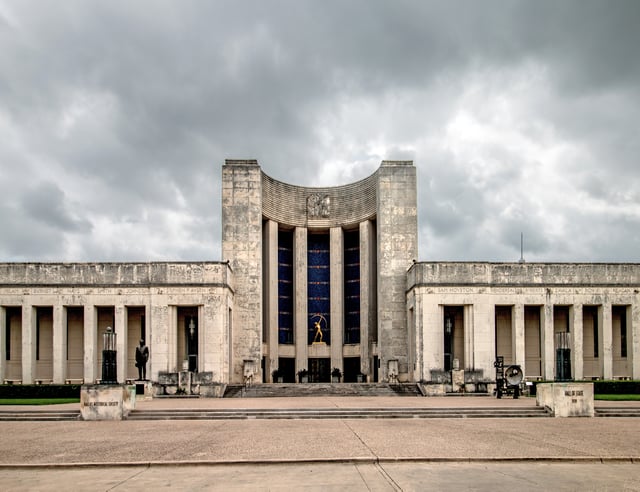
Hall of State building in Fair Park
Dallas maintains and operates 406 parks on 21,000 acres (85 km2) of parkland.
The city's parks contain 17 separate lakes, including White Rock and Bachman lakes, spanning a total of 4,400 acres (17.81 km2). In addition, Dallas is traversed by 61.6 miles (99.1 km) of biking and jogging trails, including the Katy Trail, and is home to 47 community and neighborhood recreation centers, 276 sports fields, 60 swimming pools, 232 playgrounds, 173 basketball courts, 112 volleyball courts, 126 play slabs, 258 neighborhood tennis courts, 258 picnic areas, six 18-hole golf courses, two driving ranges, and 477 athletic fields as of 2013.[155]
Fair Park
Dallas's flagship park is Fair Park. Built in 1936 for the Texas Centennial Exposition world's fair, Fair Park is the world's largest collection of Art Deco exhibit buildings, art, and sculptures; Fair Park is also home to the State Fair of Texas, the largest state fair in the United States.
Klyde Warren Park
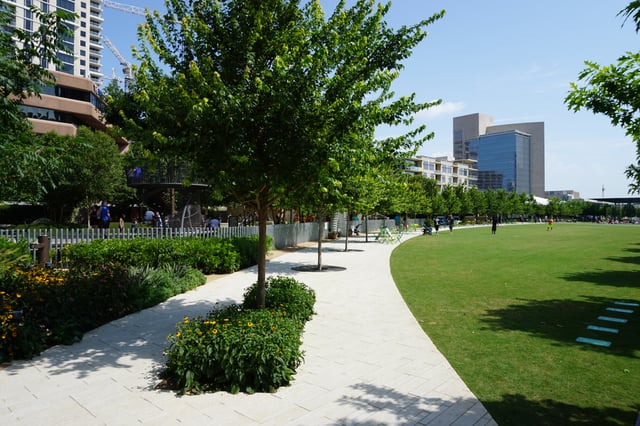
Klyde Warren Park
Named after Klyde Warren, the young son of billionaire Kelcy Warren, Klyde Warren Park was built above Woodall Rodgers Freeway and connects Uptown and Downtown, specifically the Arts District.
Klyde Warren Park is home to countless amenities, including an amphitheater, jogging trails, a children's park, My Best Friend's Park (dog park), a putting green, croquet, ping pong, chess, an outdoor library, and two restaurants: Savor and Relish. Food trucks give hungry people another option of dining and are lined along the park's Downtown side.
There are also weekly planned events, including yoga, Zumba, skyline tours, Tai Chi, and meditation.[156]
Klyde Warren Park is home to a free trolley stop on Olive St., which riders can connect to Downtown, McKinney Avenue, and West Village.
Turtle Creek Parkway park

View of Turtle Creek and Turtle Creek Boulevard from a Katy Trail overpass
Built in 1913, Turtle Creek Parkway park is a 23.7-acre linear park[157] in between Turtle Creek and Turtle Creek Boulevard in the aptly named Turtle Creek neighborhood.
Archaeological surveys discovered dart points and flint chips dating 3,000 years to 1,000 BC. This site was later discovered to be home to Native Americans who cherished the trees and natural spring water. The park is across Turtle Creek from Kalita Humphreys Theater, designed by Frank Lloyd Wright.
Lake Cliff Park

Lake Cliff Park
Opened on July 4, 1906, Lake Cliff Park was called "the Southwest's Greatest Playground". The park was home to an amusement park, a large pool, waterslides, the world's largest skating rink, and three theaters, the largest being the 2,500-seat Casino Theater. After the streetcar bridge that brought most of the park visitors collapsed, Lake Cliff Park was sold. The Casino Theater moved and the pool was demolished after a polio scare in 1959. The pool was Dallas's first municipal pool.[158]
Reverchon Park

Reverchon Park bridge

The Trinity River as viewed from Reunion Tower in Dallas in August 2015
In 1935, Dallas purchased 36 acres (15 ha) from John Cole's estate to develop Reverchon Park.[159] Reverchon Park was named after botanist Julien Reverchon, who left France to live in the La Reunion colony, which was founded in the mid-1800s[160] and was situated in present-day West Dallas. Reverchon Park was planned to be the crown jewel of the Dallas park system and was even referred to as the "Central Park" of Dallas. Improvements were made throughout the years, including the Iris Bowl, picnic settings, a baseball diamond, and tennis courts. The Iris Bowl celebrated many Greek pageants, dances, and other performances. The Gill Well was installed for nearby residents and drew people all across Texas who wanted to experience the water's healing powers.[161] The baseball diamond was host to a 1953 exhibition game for the New York Giants and the Cleveland Indians.[162]
Trinity River Project
As part of the ongoing Trinity River Project, the Great Trinity Forest, at 6,000 acres (24 km2), is the largest urban hardwood forest in the United States and is part of the largest urban park in the United States.[42] The Trinity River Audubon Center is a new addition to the park. Opened in 2008, it serves as a gateway to many trails and other nature-viewing activities in the area. The Trinity River Audubon Center is the first LEED-certified building built by the City of Dallas Parks and Recreation Department.
Katy Trail
Named after its former railroad name, the Missouri-Kansas-Texas Railroad (or "MKT" Railroad), the 3.5-mile stretch of railroad was purchased by the city of Dallas and transformed into the city's premier trail. Stretching from Victory Park, the 30-acre Katy Trail passes through the Turtle Creek and Knox Park neighborhoods and runs along the east side of Highland Park. The trail ends at Central Expressway, but extensions are underway to extend the trail to the White Rock Lake Trail in Lakewood.[158] In 2015, the Katy Trail was awarded "Best Public Place" from the Urban Land Institute.[163]
Preserves
Dallas hosts three of the twenty-one preserves of the extensive 3,200 acres (13 km2) Dallas County Preserve System. The Joppa Preserve, the McCommas Bluff Preserve, and the Cedar Ridge Preserve are within the Dallas city limits. The Cedar Ridge Preserve was known as the Dallas Nature Center, but the Audubon Dallas group now manages the 633-acre (2.56 km2) natural habitat park on behalf of the city of Dallas and Dallas County. The preserve sits at an elevation of 755 feet (230 m) above sea level and offers a variety of outdoor activities, including 10 miles (16 km) of hiking trails and picnic areas.
Dallas Zoo
Government
Local
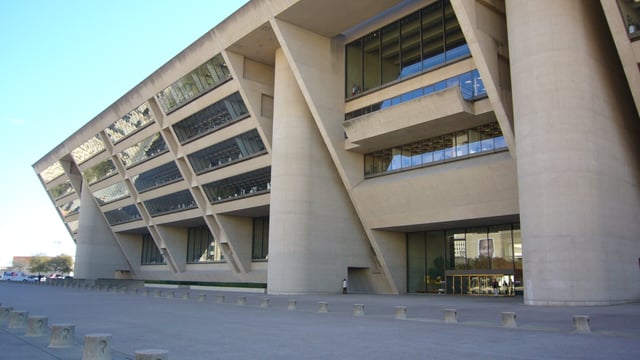
Dallas City Hall
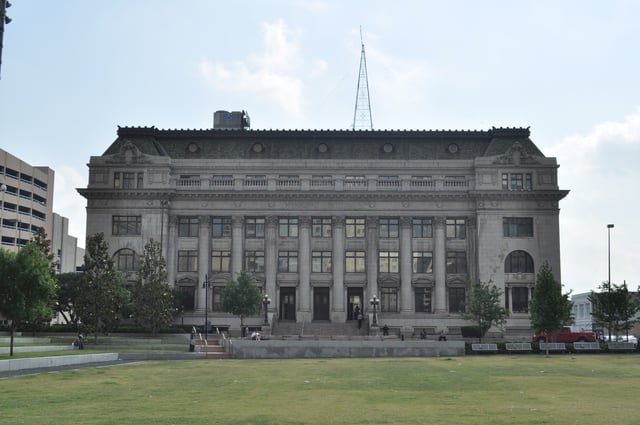
Built in 1913, the Dallas Municipal Building was Dallas's old City Hall facility

The former Dallas County Courthouse houses the Old Red Museum, displaying artifacts from Dallas County history
The city uses a council-manager government, with Eric Johnson serving as mayor,[166] T.C. Broadnax serving as city manager,[167] and 14 council members serving as representatives to the 14 council districts in the city.[168][169][170] This organizational structure was recently contested by some in favor of a strong-mayor city charter, only to be rejected by Dallas voters.
In 1969 Anita N. Martínez become the first Latin American to sit as a council women in Dallas's city council.[171]
In the 2017–2018 fiscal year, the city's total budget (the sum of operating and capital budgets) was $3.3 billion.[172] The city has seen a steady increase in its budget due to sustained growth: the budget was $1.7 billion in 2002–2003,[173] $1.9 billion in 2003–2004,[173] $2.0 billion in 2004–2005,[174] and $2.2 billion in 2005–2006.[174]
Federal and state
National and state legislators representing Dallas:
| Federal[175] | |||||
| House of Representatives | Senate | ||||
| Name | Party | District | Name | Party | |
| Van Taylor | Republican | District 3 | John Cornyn | Republican | |
| Lance Gooden | Republican | District 5 | Ted Cruz | Republican | |
| Kenny Marchant | Republican | District 24 | |||
| Michael C. Burgess | Republican | District 26 | |||
| Eddie Bernice Johnson | Democrat | District 30 | |||
| Colin Allred | Democrat | District 32 | |||
| Marc Veasey | Democrat | District 33 | |||
| State[175] | |||||
| House of Representatives | Senate | ||||
| Name | Party | District | Name | Party | District |
| Vacant | Vacant | District 100 | Bob Hall[1] [246] | Republican | District 2 |
| Ana-Maria Ramos | Democrat | District 102 | Angela Paxton[2] [247] | Republican | District 8 |
| Rafael Anchia | Democrat | District 103 | Kelly Hancock[3] [248] | Republican | District 9 |
| Jessica González | Democrat | District 104 | Nathan M. Johnson[4] [249] | Democrat | District 16 |
| Terry Meza | Democrat | District 105 | Royce West[5] [250] | Democrat | District 23 |
| Victoria Neave | Democrat | District 107 | |||
| Morgan Meyer | Republican | District 108 | |||
| Helen Giddings | Democrat | District 109 | |||
| Toni Rose | Democrat | District 110 | |||
| Yvonne Davis | Democrat | District 111 | |||
| Angie Chen Button | Republican | District 112 | |||
| Rhetta Bowers | Democrat | District 113 | |||
| John Turner | Democrat | District 114 | |||
| Julie Johnson | Democrat | District 115 | |||
The United States District Court for the Northern District of Texas, which exercises original jurisdiction over 100 counties in North and West Texas, convenes in the Earle Cabell Federal Building and Courthouse in the Government District of Downtown. The same building additionally houses United States Bankruptcy and Magistrate Courts and a United States Attorney office. Dallas also is the seat of the Fifth Court of Appeals of Texas.
Politics
Overall, Dallas is a Democratic-leaning city, with Democratic voters spreading the majority of the city, especially the central and southern sectors, and conservative Republicans dominating a sliver of suburban neighborhoods in North Dallas.
Jim Schutze of the Dallas Observer said in 2002 "the early vote in majority-black precincts in Southern Dallas is the city's only disciplined vote. Especially in citywide elections on issues that are not entwined in the internal politics of the black community, the Southern Dallas African-American vote has a history of responding obediently to the call of leadership."[176]
In the 2004 U.S. Presidential elections, 57% of Dallas voters voted for John Kerry over George W. Bush.[177] Dallas County was closely divided, with 50% of voters voting for Bush and 49% voting for Kerry.[178]
Results in the 2008 and 2012 elections favored Barack Obama, with the 44th President receiving 57% of Dallas County voters in both years, with greater margins in the city of Dallas.
In the 2016 U.S. Presidential election, approximately 66% of Dallas voters voted for Hillary Clinton, with 28% of city voters voting for Donald Trump.[179] Dallas County as a whole saw 61% of voters voting for Clinton, with 35% support for Trump.[179]
In 2004, Lupe Valdez was elected Dallas County Sheriff. An open lesbian, Valdez was the only female sheriff in the state of Texas until her resignation. Despite controversies in her handling of county jails, she won re-election in 2008 with a 10-point victory over Republican challenger Lowell Cannaday.[180]
Education
Colleges and universities
The Dallas area has the highest concentration of colleges and universities in Texas. In addition to those in the city, the surrounding cities also has a number of universities, colleges, trade schools, and other educational institutions. The following describes the universities and their proximity to the city:
Colleges and universities in the Dallas city limits

UT Southwestern
UT Southwestern Medical Center ("UTSW") is a prominent academic medical center north of downtown Dallas in the Southwestern Medical District, ranked in the top 30 nationally by US News & World Report every year (in both Research and Clinical categories).[183] Six Nobel laureates are among its faculty[184], and UTSW was ranked #1 in the world among healthcare institutions in biomedical sciences by Nature in 2019.[185] The main teaching hospital of the university also ranks among the top 3 hospitals in the state of Texas.[186]. UTSW is part of the University of Texas System.
Texas Woman's University has operated a nursing school in Dallas at Parkland Memorial Hospital since 1966. The T. Boone Pickens Institute of Health Sciences-Dallas Center (IHSD) was opened in 2011 and is a purpose-built educational facility that replaced the building TWU had used since 1966. TWU also operated an occupational therapy school at Presbyterian Hospital of Dallas from 1977 through 2011 before consolidating those functions into the new IHSD building at Parkland.[187]
Paul Quinn College is a private, historically black college in southeast Dallas. Originally located in Waco, Texas, it moved to Dallas in 1990 and is housed on the campus of the former Bishop College, another private, historically black college. Dallas billionaire and entrepreneur Comer Cottrell, Jr., founder of ProLine Corporation, bought the campus of Bishop College and bequeathed it to Paul Quinn College in 1990 making it the only historically black college in the Dallas area.[188]
The University of North Texas at Dallas is along Houston School Road.[189] In 2009 UNT at Dallas became the first public university within Dallas city limits.[190] The University of North Texas System requested approval from the Texas Legislature and Texas Higher Education Coordinating Board for the state's first new public law school in more than 40 years. The University of North Texas at Dallas College of Law was planned to be based at the Old Municipal Building in Downtown Dallas.[191]
Dallas Baptist University is a private, coeducational university in the Mountain Creek area of southwest Dallas. Originally in Decatur, Texas, the school moved to Dallas in 1965.[192] The school enrolls over 5,600 students,[193] and offers undergraduate, graduate, and doctoral degrees. Popular subjects include Biblical studies, business, and music degrees. DBU has been recognized by the National Council on Teacher Quality for their high-quality teacher preparatory degrees.[194] The school also maintains an Intensive English Program for international students wishing to enhance their knowledge of the English language. The campus is a Tree Campus USA and is recognized as one of the most beautiful university campuses in the Southwest U.S.[195] The school has also become nationally recognized for its baseball team which has made several playoff runs.
Dallas Theological Seminary, also within the city limits, is recognized as one of the leading seminaries in Evangelical Protestantism. Situated 3 miles (5 km) east of Downtown Dallas, it has over 2,000 graduate students and has graduated over 12,000 alumni.
Criswell College is within two blocks of Dallas Theological Seminary. Criswell was started by First Baptist Church of Dallas in the early 1970s.
Dallas County Community College District, the 2-year educational institution of Dallas County, has seven campuses throughout the area with branches in Dallas as well as the surrounding suburbs. DCCCD serves portions of Dallas in Dallas County.
Colleges and universities in Dallas County

Dallas Hall at Southern Methodist University in University Park, Texas

Residence Hall at the University of Texas at Dallas
Southern Methodist University is a private, coeducational university in University Park, an independent city that, together with the adjacent town of Highland Park, Dallas surrounds entirely. SMU was founded in 1911 by the Southern Methodist Church, and is now run by R. Gerald Turner. According to sources such as the U.S. News & World Report, SMU is the best overall undergraduate college in the Dallas–Fort Worth metroplex and the third best in the State of Texas.
The University of Texas at Dallas is a part of the University of Texas System. It is in the city of Richardson, about 15 miles north of Downtown Dallas. It is in the heart of the Telecom Corridor. UT Dallas is an R1 or Tier-1 University, classified by the Carnegie Commission on Higher Education as a doctoral-granting university with the highest research activity (it is among 115 universities in the US with this classification). UTD was ranked #3 (2013, 2015), #1 (2017), and #2 (2019) in the United States in the Times Higher Education "Young University Rankings" of the best universities that are 50 years old or younger.[196] The university has many collaborative research relationships with UT Southwestern Medical Center.
The University of Dallas, in the suburb of Irving, is an enclave of Roman Catholicism in the majority Protestant religious landscape of Dallas–Fort Worth. St. Albert the Great Dominican Priory and Holy Trinity Seminary are on campus, while the Cistercian Monastery and Cistercian Preparatory School are just north of the UD campus across Texas State Highway 114. The Highlands School, a PK–12 Legionary school, is just west of the UD campus and connects to campus by jogging trails. As a center for religious study, the Cistercian Monastery continues to be notable for scholastic developments in theology.
Located in Downtown Dallas, El Centro College is the flagship institution of the Dallas County Community College District. El Centro first opened its campus doors in 1966 and now enrolls over 10,000 students. El Centro was the first college of the DCCCD to offer a nursing program and has established relationships with several top-notch hospitals in the Dallas area. The college is also the only campus within DCCCD that offers a Food & Hospitality Program as well as renowned programs in fashion design and fashion marketing.[197]
University Research Center
Texas A&M-Dallas Research and Extension Center[198]
Other area colleges and universities
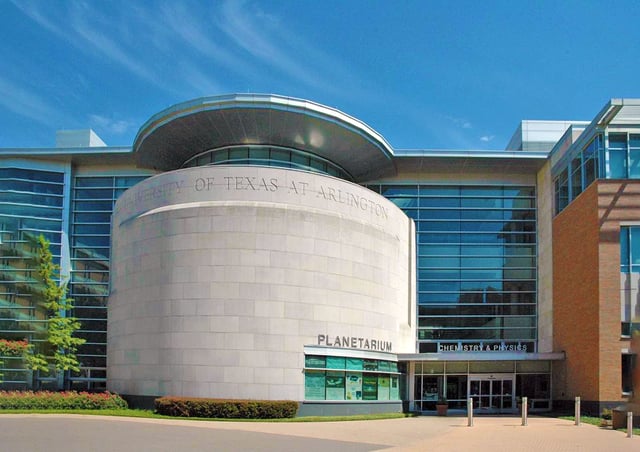
Chemistry & Physics Building with planetarium at The University of Texas at Arlington
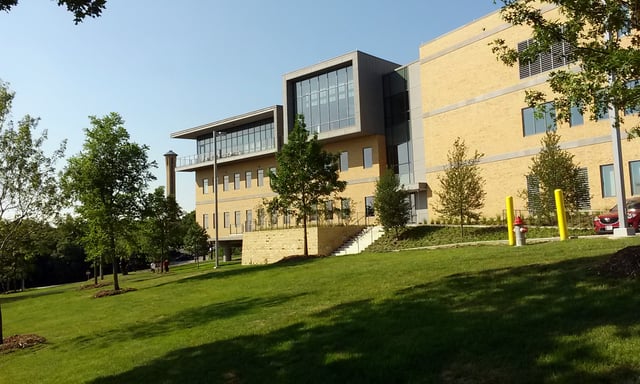
SB Hall with Braniff Tower in the background at the University of Dallas
The University of Texas at Arlington
The University of North Texas in Denton
Texas Woman's University in Denton
Tarleton State University in Fort Worth
University of Phoenix in Dallas, Irving, Plano, Arlington, Hurst, and Cedar Hill
Dallas Christian College in Farmers Branch
Arlington Baptist College
Collin College in Collin County
Remington College in Garland
Remington College in Fort Worth
Texas Christian University
Texas Wesleyan University
University of North Texas Health Science Center at Fort Worth
Austin College in Sherman
Texas A&M University–Commerce
Southwestern Assemblies of God University in nearby Waxahachie
Navarro College in Corsicana
Tarrant County College in Tarrant County
Primary and secondary schools
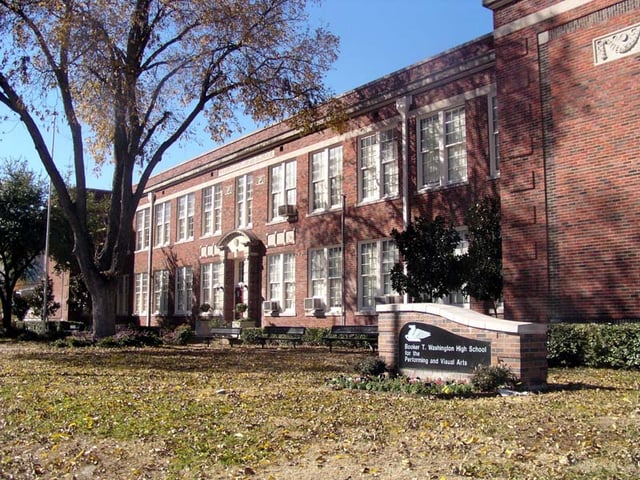
Booker T. Washington High School for the Performing and Visual Arts in the Arts District
Most people in the city of Dallas are within the Dallas Independent School District, the 12th-largest school district in the United States and second largest in Texas.[199] The school district operates independently of the city and enrolls over 161,000 students.[199] As of 2003 DISD has the majority of K-12 students in the city of Dallas, and a proportionately larger number of students who are not non-Hispanic white.[200] One of the district's magnet schools, the School for the Talented and Gifted in Oak Cliff, is consistently named the best public school in the United States by Newsweek, retaining the title for five consecutive years (2012–2016).[201] Another one of DISD's schools, the Science and Engineering Magnet, consistently ranks in the top 10 in the same publication.[202][203] Other Dallas high schools named to the list were Hillcrest, W. T. White, Williams Preparatory, and Woodrow Wilson high schools. Woodrow Wilson was also named the top comprehensive high school in Dallas by local publication D Magazine.
A few areas of Dallas also extend into other school districts, including Carrollton-Farmers Branch, Coppell, Duncanville, Garland,[204] Highland Park, Mesquite, Plano, and Richardson. The Plano and Richardson school districts have the largest numbers of public school students in Dallas who are not in Dallas ISD.[200] The Wilmer-Hutchins Independent School District once served portions of southern Dallas, but it was shut down for the 2005–2006 year. WHISD students started attending other Dallas ISD schools during that time. Following the close, the Texas Education Agency consolidated WHISD into Dallas ISD.
Many school districts in Dallas County, including Dallas ISD, are served by a governmental agency called Dallas County Schools. The system provides busing and other transportation services, access to a massive media library, technology services, strong ties to local organizations for education/community integration, and staff development programs.[205]
Private schools
There are many private schools in Dallas, such as Bishop Dunne Catholic School, Bishop Lynch High School, Burton Adventist Academy, Calvary Lutheran School,[206] Dallas Christian Adventist Academy, Dallas Lutheran School, The da Vinci School, Greenhill School, Episcopal School of Dallas, First Baptist Academy of Dallas, The Hockaday School, Jesuit College Preparatory School of Dallas, June Shelton School, Lakehill Preparatory School, The Lamplighter School, Parish Episcopal School, St. Mark's School of Texas, Ursuline Academy of Dallas, The Winston School, and Yavneh Academy of Dallas and Dallas Christian School (on the borders of Mesquite and Garland) and Tyler Street Christian Academy in Oak Cliff. Some Dallas residents attend Cistercian Preparatory School in adjacent Irving, The Highlands School in Irving, Trinity Christian Academy in Addison, and John Paul II High School in Plano.
Media
Dallas has several local newspapers, magazines, television stations and radio stations that serve the Dallas–Fort Worth metroplex, which is the 5th-largest media market in the United States.[207] Dallas has one major daily newspaper, The Dallas Morning News, which was founded in 1885 by A. H. Belo and is A. H. Belo's flagship newspaper. The Dallas Times Herald, started in 1888, was the Morning News' major competitor until Belo purchased it on December 8, 1991 and closed the paper down the next day. Other daily newspapers are Al Día, a Spanish-language paper published by Belo, and a number of ethnic newspapers printed in languages such as Chinese, Korean, and Vietnamese.
Other publications include the Dallas Weekly and the Elite News, all weekly news publications. The Dallas Observer and the North Texas Journal are also alternative weekly newspapers. The Dallas Morning News formerly had a weekly publication, Neighborsgo, which came out every Friday and focused on community news. Readers could post stories and contribute content to the website. D Magazine is a notable monthly magazine about business, life, and entertainment in Dallas-Fort Worth. Local visitor magazines include "WHERE Magazine" and "Travelhost"–available at hotel desks or in guest rooms. In addition, the Park Cities and suburbs such as Plano also have their own community newspapers. Also, THE Magazine covers the contemporary arts scene.
In terms of the larger metro area, the Fort Worth Star-Telegram is another major daily newspaper, covering Fort Worth/Tarrant County and its suburbs. It also publishes a major Spanish-language newspaper for the entire metro area known as La Estrella. To the north of Dallas and Fort Worth, the Denton Record-Chronicle primarily covers news for the city of Denton and Denton County.
Area television stations affiliated with the major broadcasting networks (network O&O's highlighted in bold) include KDFW 4 (Fox), KXAS 5 (NBC), WFAA 8 (ABC) (which for many years was owned by Belo alongside the Morning News), KTVT 11 (CBS), KERA 13 (PBS), KUVN 23 (UNI), KDFI 27 (MNTV), KDAF 33 (The CW), and KXTX 39 (TMD). KTXA-21 is an independent station formerly affiliated with the now-defunct UPN network.
Over 101 radio stations operate within range of Dallas.[208] The city of Dallas operates WRR 101.1 FM, the area's main classical music station, from city offices in Fair Park.[209] Its original sister station, licensed as WRR-AM in 1921, is the oldest commercially operated radio station in Texas and the second-oldest in the United States, after KDKA (AM) in Pittsburgh.[210] Because of the city's central geographical position and lack of nearby mountainous terrain, high-power class A medium-wave stations KRLD and WBAP can broadcast as far as southern Canada at night and can be used for emergency messages when broadcasting is down in other major metropolitan areas in the United States.
Slavic Voice of America media group serves Russian-speaking Americans out of Dallas.
Infrastructure
Public safety
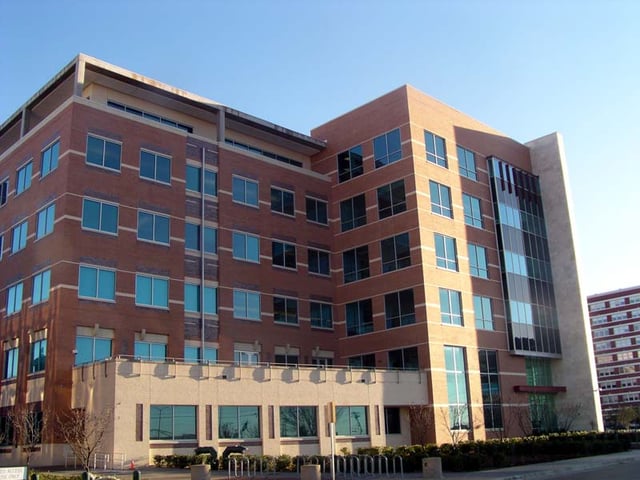
The Dallas Police headquarters in the Cedars neighborhood
The Dallas Police Department provides most policing in Dallas. The Dallas chief of police is U. Renee Hall (effective Sept. 5, 2017).[213] The police headquarters are in the Cedars neighborhood of southern Dallas.
Fire protection and emergency medical services in the city are provided by the Dallas Fire-Rescue Department. The Dallas Fire & Rescue chief is David Coatney.[214] The department operates the Dallas Firefighter's Museum built in 1907 along Parry Avenue near Fair Park. Dallas's oldest remaining fire station building still stands at the corner of McKinney Ave. and Leonard and was built in 1892. It was the home of Engine Co. Number 1, and is now a picture framing shop.
Health care
Dallas has many hospitals and several medical research facilities within its city limits. One major research center is the Dallas Medical District with the UT Southwestern Medical Center in the Stemmons Corridor, along with the affiliated UT Southwestern Medical School. The health care complex includes within its bounds Parkland Memorial Hospital, Children's Medical Center, William P. Clements Jr. University Hospital (formerly St. Paul University Hospital), and the Zale Lipshy Pavilion – William P. Clements Jr. University Hospital.
Dallas also has a VA hospital in the southern portion of the city, the Dallas Veterans Affairs Medical Center. The center is home to a Consolidated Mail Outpatient Pharmacy (CMOP), part of an initiative by the Department of Veterans Affairs to provide mail-order prescriptions to veterans using computerization at strategic locations throughout the United States.
Other hospitals in the city include Baylor University Medical Center in East Dallas, Methodist Dallas Medical Center in Oak Cliff, Methodist Charlton Medical Center near Duncanville, Medical City Dallas Hospital and Presbyterian Hospital in North Dallas, and the Texas Scottish Rite Hospital for Children in Oak Lawn.
Utilities
Dallas is served by Dallas Water Utilities, which operates several waste treatment plants and pulls water from several area reservoirs.[215] Several companies maintain the city's electric system, including Stream Energy, Cirro Energy and Oncor Electric Delivery,[216] whose parent company, Energy Future Holdings Corporation, has headquarters in the city.[217]
The city offers garbage pickup and recycling service weekly through its Sanitation Services department.[218] Telephone networks, broadband internet, and cable television service are available from several companies, including AT&T, Time Warner Cable, and Verizon FiOS.
Transportation
Like many other major cities in the United States, the automobile is the primary mode of local transportation, though efforts have been made to increase the availability of alternative modes of transportation, including the construction of light rail lines, biking and walking paths, wide sidewalks, a trolley system, and buses. Walk Score ranked Dallas the twenty-third most walkable of fifty largest cities in the United States in 2011.[219]
In 2009, 78.5% of Dallas (city) commuters drive to work alone. The 2009 mode share for Dallas (city) commuters are 10.7% for carpooling, 3.9% for transit, 1.9% for walking, and .1% for cycling.[220] In 2015, the American Community Survey estimated modal shares for Dallas (city) commuters of 75.4% for driving alone, 12.8% for carpooling, 3.5% for riding transit, 1.9% for walking, and .2% for cycling.[221] The city of Dallas has a higher than average percentage of households without a car. In 2015, 10.2 percent of Dallas households lacked a car, and decreased to 9.1 percent in 2016. The national average was 8.7 percent in 2016. Dallas averaged 1.59 cars per household in 2016, compared to a national average of 1.8.[222]
Highways

The Central Expressway and I-635 interchange, commonly known as the High Five Interchange
Dallas is at the confluence of four major interstate highways—Interstates 20, 30, 35E, and 45. The Dallas area freeway system is set up in the popular hub-and-spoke system, shaped much like a wagon wheel. Starting from the center of the city, a small freeway loop surrounds Downtown, followed by the Interstate 635 loop about 10 miles (16 km) outside Downtown, and ultimately the tolled President George Bush Turnpike. Inside these freeway loops are other boulevard- and parkway-style loops, including Loop 12 and Belt Line Road. Another beltway around the city upwards of 45 miles (72 km) from Downtown is under plan in Collin County.
Radiating out of Downtown Dallas's freeway loop are the spokes of the area's highway system—Interstates 30, 35E, and 45, U.S. Highway 75, U.S. Highway 175, State Spur 366, the Dallas North Tollway, State Highway 114, U.S. Highway 80, and U.S. Highway 67. Other major highways around the city include State Highway 183 and State Spur 408.
The recently completed interchange at the intersection of Lyndon B. Johnson Freeway (Interstate 635) and Central Expressway (U.S. Highway 75) has five stacks and is aptly called the High Five Interchange. It is one of the few five-level interchanges in Dallas and is one of the largest freeway interchanges in the United States.
The following is a list of the freeways and tollways in the Dallas and Fort Worth area:
[[INLINE_IMAGE|//upload.wikimedia.org/wikipedia/commons/thumb/3/36/I-20_%28TX%29.svg/20px-I-20_%28TX%29.svg.png|//upload.wikimedia.org/wikipedia/commons/thumb/3/36/I-20_%28TX%29.svg/30px-I-20_%28TX%29.svg.png 1.5x, //upload.wikimedia.org/wikipedia/commons/thumb/3/36/I-20_%28TX%29.svg/40px-I-20_%28TX%29.svg.png 2x|I-20 (TX).svg|h20|w20]] Interstate 20
[[INLINE_IMAGE|//upload.wikimedia.org/wikipedia/commons/thumb/3/33/I-30_%28TX%29.svg/20px-I-30_%28TX%29.svg.png|//upload.wikimedia.org/wikipedia/commons/thumb/3/33/I-30_%28TX%29.svg/30px-I-30_%28TX%29.svg.png 1.5x, //upload.wikimedia.org/wikipedia/commons/thumb/3/33/I-30_%28TX%29.svg/40px-I-30_%28TX%29.svg.png 2x|I-30 (TX).svg|h20|w20]] Interstate 30
[[INLINE_IMAGE|//upload.wikimedia.org/wikipedia/commons/thumb/5/52/I-35E_%28TX%29.svg/25px-I-35E_%28TX%29.svg.png|//upload.wikimedia.org/wikipedia/commons/thumb/5/52/I-35E_%28TX%29.svg/38px-I-35E_%28TX%29.svg.png 1.5x, //upload.wikimedia.org/wikipedia/commons/thumb/5/52/I-35E_%28TX%29.svg/50px-I-35E_%28TX%29.svg.png 2x|I-35E (TX).svg|h20|w25]] Interstate 35E
[[INLINE_IMAGE|//upload.wikimedia.org/wikipedia/commons/thumb/d/d8/I-35W_%28TX%29.svg/25px-I-35W_%28TX%29.svg.png|//upload.wikimedia.org/wikipedia/commons/thumb/d/d8/I-35W_%28TX%29.svg/38px-I-35W_%28TX%29.svg.png 1.5x, //upload.wikimedia.org/wikipedia/commons/thumb/d/d8/I-35W_%28TX%29.svg/50px-I-35W_%28TX%29.svg.png 2x|I-35W (TX).svg|h20|w25]] Interstate 35W
[[INLINE_IMAGE|//upload.wikimedia.org/wikipedia/commons/thumb/d/db/I-45_%28TX%29.svg/20px-I-45_%28TX%29.svg.png|//upload.wikimedia.org/wikipedia/commons/thumb/d/db/I-45_%28TX%29.svg/30px-I-45_%28TX%29.svg.png 1.5x, //upload.wikimedia.org/wikipedia/commons/thumb/d/db/I-45_%28TX%29.svg/40px-I-45_%28TX%29.svg.png 2x|I-45 (TX).svg|h20|w20]] Interstate 45
[[INLINE_IMAGE|//upload.wikimedia.org/wikipedia/commons/thumb/c/c2/I-635_%28TX%29.svg/25px-I-635_%28TX%29.svg.png|//upload.wikimedia.org/wikipedia/commons/thumb/c/c2/I-635_%28TX%29.svg/38px-I-635_%28TX%29.svg.png 1.5x, //upload.wikimedia.org/wikipedia/commons/thumb/c/c2/I-635_%28TX%29.svg/50px-I-635_%28TX%29.svg.png 2x|I-635 (TX).svg|h20|w25]] Interstate 635
[[INLINE_IMAGE|//upload.wikimedia.org/wikipedia/commons/thumb/3/36/I-820_%28TX%29.svg/25px-I-820_%28TX%29.svg.png|//upload.wikimedia.org/wikipedia/commons/thumb/3/36/I-820_%28TX%29.svg/38px-I-820_%28TX%29.svg.png 1.5x, //upload.wikimedia.org/wikipedia/commons/thumb/3/36/I-820_%28TX%29.svg/50px-I-820_%28TX%29.svg.png 2x|I-820 (TX).svg|h20|w25]] Interstate 820
[[INLINE_IMAGE|//upload.wikimedia.org/wikipedia/commons/thumb/6/6c/US_67.svg/20px-US_67.svg.png|//upload.wikimedia.org/wikipedia/commons/thumb/6/6c/US_67.svg/30px-US_67.svg.png 1.5x, //upload.wikimedia.org/wikipedia/commons/thumb/6/6c/US_67.svg/40px-US_67.svg.png 2x|US 67.svg|h20|w20]] U.S. Highway 67
[[INLINE_IMAGE|//upload.wikimedia.org/wikipedia/commons/thumb/e/e4/US_75.svg/20px-US_75.svg.png|//upload.wikimedia.org/wikipedia/commons/thumb/e/e4/US_75.svg/30px-US_75.svg.png 1.5x, //upload.wikimedia.org/wikipedia/commons/thumb/e/e4/US_75.svg/40px-US_75.svg.png 2x|US 75.svg|h20|w20]] U.S. Highway 75
[[INLINE_IMAGE|//upload.wikimedia.org/wikipedia/commons/thumb/9/9a/US_80.svg/20px-US_80.svg.png|//upload.wikimedia.org/wikipedia/commons/thumb/9/9a/US_80.svg/30px-US_80.svg.png 1.5x, //upload.wikimedia.org/wikipedia/commons/thumb/9/9a/US_80.svg/40px-US_80.svg.png 2x|US 80.svg|h20|w20]] U.S. Highway 80
[[INLINE_IMAGE|//upload.wikimedia.org/wikipedia/commons/thumb/f/f9/US_175.svg/25px-US_175.svg.png|//upload.wikimedia.org/wikipedia/commons/thumb/f/f9/US_175.svg/38px-US_175.svg.png 1.5x, //upload.wikimedia.org/wikipedia/commons/thumb/f/f9/US_175.svg/50px-US_175.svg.png 2x|US 175.svg|h20|w25]] U.S. Highway 175
[[INLINE_IMAGE|//upload.wikimedia.org/wikipedia/commons/thumb/7/7a/US_287.svg/25px-US_287.svg.png|//upload.wikimedia.org/wikipedia/commons/thumb/7/7a/US_287.svg/38px-US_287.svg.png 1.5x, //upload.wikimedia.org/wikipedia/commons/thumb/7/7a/US_287.svg/50px-US_287.svg.png 2x|US 287.svg|h20|w25]] U.S. Highway 287
[[INLINE_IMAGE|//upload.wikimedia.org/wikipedia/commons/thumb/7/72/Texas_114.svg/20px-Texas_114.svg.png|//upload.wikimedia.org/wikipedia/commons/thumb/7/72/Texas_114.svg/30px-Texas_114.svg.png 1.5x, //upload.wikimedia.org/wikipedia/commons/thumb/7/72/Texas_114.svg/40px-Texas_114.svg.png 2x|Texas 114.svg|h20|w20]] State Highway 114
[[INLINE_IMAGE|//upload.wikimedia.org/wikipedia/commons/thumb/2/28/Texas_121.svg/20px-Texas_121.svg.png|//upload.wikimedia.org/wikipedia/commons/thumb/2/28/Texas_121.svg/30px-Texas_121.svg.png 1.5x, //upload.wikimedia.org/wikipedia/commons/thumb/2/28/Texas_121.svg/40px-Texas_121.svg.png 2x|Texas 121.svg|h20|w20]] [[INLINE_IMAGE|//upload.wikimedia.org/wikipedia/commons/thumb/1/18/Toll_Texas_121.svg/20px-Toll_Texas_121.svg.png|//upload.wikimedia.org/wikipedia/commons/thumb/1/18/Toll_Texas_121.svg/30px-Toll_Texas_121.svg.png 1.5x, //upload.wikimedia.org/wikipedia/commons/thumb/1/18/Toll_Texas_121.svg/40px-Toll_Texas_121.svg.png 2x|Toll Texas 121.svg|h20|w20]] State Highway 121
[[INLINE_IMAGE|//upload.wikimedia.org/wikipedia/commons/thumb/d/d0/Texas_161.svg/20px-Texas_161.svg.png|//upload.wikimedia.org/wikipedia/commons/thumb/d/d0/Texas_161.svg/30px-Texas_161.svg.png 1.5x, //upload.wikimedia.org/wikipedia/commons/thumb/d/d0/Texas_161.svg/40px-Texas_161.svg.png 2x|Texas 161.svg|h20|w20]] State Highway 161
[[INLINE_IMAGE|//upload.wikimedia.org/wikipedia/commons/thumb/f/fc/Texas_183.svg/20px-Texas_183.svg.png|//upload.wikimedia.org/wikipedia/commons/thumb/f/fc/Texas_183.svg/30px-Texas_183.svg.png 1.5x, //upload.wikimedia.org/wikipedia/commons/thumb/f/fc/Texas_183.svg/40px-Texas_183.svg.png 2x|Texas 183.svg|h20|w20]] State Highway 183
[[INLINE_IMAGE|//upload.wikimedia.org/wikipedia/commons/thumb/b/bf/Texas_190.svg/20px-Texas_190.svg.png|//upload.wikimedia.org/wikipedia/commons/thumb/b/bf/Texas_190.svg/30px-Texas_190.svg.png 1.5x, //upload.wikimedia.org/wikipedia/commons/thumb/b/bf/Texas_190.svg/40px-Texas_190.svg.png 2x|Texas 190.svg|h20|w20]] State Highway 190
[[INLINE_IMAGE|//upload.wikimedia.org/wikipedia/commons/thumb/2/20/Texas_360.svg/20px-Texas_360.svg.png|//upload.wikimedia.org/wikipedia/commons/thumb/2/20/Texas_360.svg/30px-Texas_360.svg.png 1.5x, //upload.wikimedia.org/wikipedia/commons/thumb/2/20/Texas_360.svg/40px-Texas_360.svg.png 2x|Texas 360.svg|h20|w20]] State Highway 360
[[INLINE_IMAGE|//upload.wikimedia.org/wikipedia/commons/thumb/9/92/Texas_Loop_12.svg/20px-Texas_Loop_12.svg.png|//upload.wikimedia.org/wikipedia/commons/thumb/9/92/Texas_Loop_12.svg/30px-Texas_Loop_12.svg.png 1.5x, //upload.wikimedia.org/wikipedia/commons/thumb/9/92/Texas_Loop_12.svg/40px-Texas_Loop_12.svg.png 2x|Texas Loop 12.svg|h20|w20]] Loop 12
[[INLINE_IMAGE|//upload.wikimedia.org/wikipedia/commons/thumb/9/9f/Texas_Spur_366.svg/20px-Texas_Spur_366.svg.png|//upload.wikimedia.org/wikipedia/commons/thumb/9/9f/Texas_Spur_366.svg/30px-Texas_Spur_366.svg.png 1.5x, //upload.wikimedia.org/wikipedia/commons/thumb/9/9f/Texas_Spur_366.svg/40px-Texas_Spur_366.svg.png 2x|Texas Spur 366.svg|h20|w20]] Spur 366
[[INLINE_IMAGE|//upload.wikimedia.org/wikipedia/commons/thumb/1/15/Texas_Spur_408.svg/20px-Texas_Spur_408.svg.png|//upload.wikimedia.org/wikipedia/commons/thumb/1/15/Texas_Spur_408.svg/30px-Texas_Spur_408.svg.png 1.5x, //upload.wikimedia.org/wikipedia/commons/thumb/1/15/Texas_Spur_408.svg/40px-Texas_Spur_408.svg.png 2x|Texas Spur 408.svg|h20|w20]] Spur 408
[[INLINE_IMAGE|//upload.wikimedia.org/wikipedia/commons/thumb/1/1a/Texas_Spur_482.svg/20px-Texas_Spur_482.svg.png|//upload.wikimedia.org/wikipedia/commons/thumb/1/1a/Texas_Spur_482.svg/30px-Texas_Spur_482.svg.png 1.5x, //upload.wikimedia.org/wikipedia/commons/thumb/1/1a/Texas_Spur_482.svg/40px-Texas_Spur_482.svg.png 2x|Texas Spur 482.svg|h20|w20]] Spur 482
[[INLINE_IMAGE|//upload.wikimedia.org/wikipedia/commons/thumb/5/53/Toll_Texas_DNT_new.svg/20px-Toll_Texas_DNT_new.svg.png|//upload.wikimedia.org/wikipedia/commons/thumb/5/53/Toll_Texas_DNT_new.svg/30px-Toll_Texas_DNT_new.svg.png 1.5x, //upload.wikimedia.org/wikipedia/commons/thumb/5/53/Toll_Texas_DNT_new.svg/40px-Toll_Texas_DNT_new.svg.png 2x|Toll Texas DNT new.svg|h20|w20]] Dallas North Tollway
[[INLINE_IMAGE|//upload.wikimedia.org/wikipedia/commons/thumb/e/e8/Toll_Texas_PGBT_new.svg/20px-Toll_Texas_PGBT_new.svg.png|//upload.wikimedia.org/wikipedia/commons/thumb/e/e8/Toll_Texas_PGBT_new.svg/30px-Toll_Texas_PGBT_new.svg.png 1.5x, //upload.wikimedia.org/wikipedia/commons/thumb/e/e8/Toll_Texas_PGBT_new.svg/40px-Toll_Texas_PGBT_new.svg.png 2x|Toll Texas PGBT new.svg|h20|w20]] President George Bush Turnpike
[[INLINE_IMAGE|//upload.wikimedia.org/wikipedia/commons/thumb/e/ec/Toll_Texas_SRT_new.svg/20px-Toll_Texas_SRT_new.svg.png|//upload.wikimedia.org/wikipedia/commons/thumb/e/ec/Toll_Texas_SRT_new.svg/30px-Toll_Texas_SRT_new.svg.png 1.5x, //upload.wikimedia.org/wikipedia/commons/thumb/e/ec/Toll_Texas_SRT_new.svg/40px-Toll_Texas_SRT_new.svg.png 2x|Toll Texas SRT new.svg|h20|w20]] Sam Rayburn Tollway
Airports
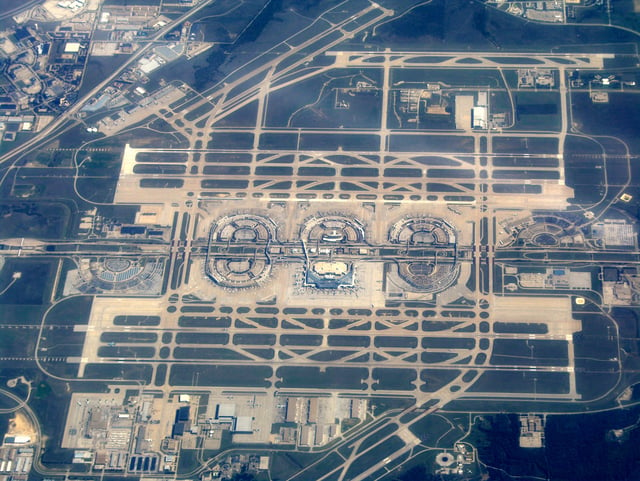
In 2015, the DFW International Airport was the 10th busiest airport in the world by passenger traffic.
Two commercial airports serve Dallas: Dallas/Fort Worth International Airport and Dallas Love Field. In addition, Dallas Executive Airport (formerly Redbird Airport), serves as a general aviation airport for the city, and Addison Airport functions similarly just outside the city limits in the suburb of Addison. Two more general aviation airports are about 35 miles (56 km) north of Dallas in McKinney, and another two are in Fort Worth, on the west side of the metroplex. Alliance Airport, in far North Fort Worth, is a cargo reliever airport to DFW and general aviation facility.
DFW International Airport is in the suburbs slightly north of and equidistant to Downtown Fort Worth and Downtown Dallas. In terms of size, DFW International is the largest airport in the state, the 2nd largest in the United States, and 9th largest in the world; DFW International Airport is larger than the island of Manhattan.
In terms of traffic, DFW International is the busiest airport in the state, 4th busiest in the United States, and 11th busiest in the world. The headquarters of American Airlines, the largest air carrier in the world ahead of United Airlines and Delta Air Lines, is less than a mile from DFW International within Fort Worth's city limits. Similarly, Love Field is within Dallas's city limits, about 6 miles (10 km) northwest of Downtown, and is headquarters to Southwest Airlines, the largest domestic airline in the United States.
Transit systems
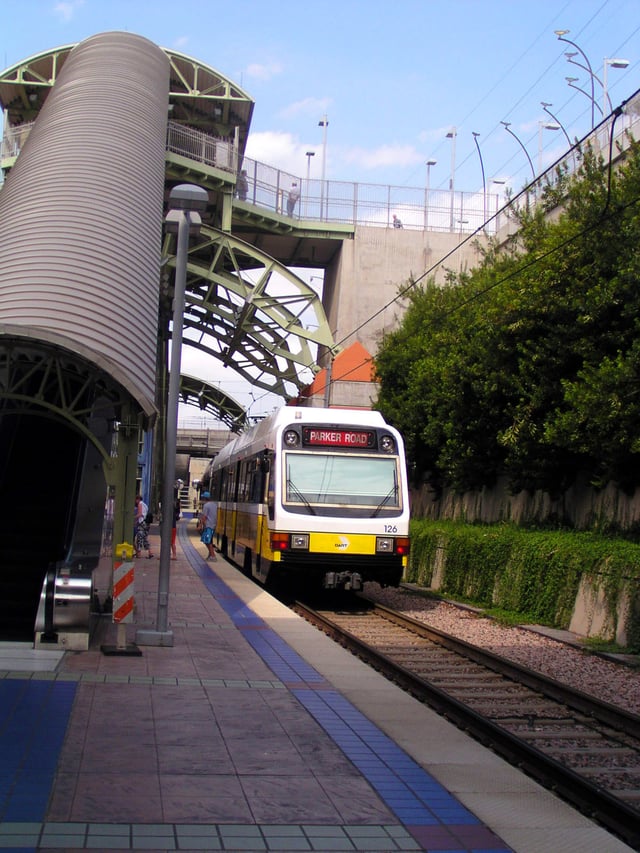
A northbound train at the Mockingbird Station
Dallas Area Rapid Transit (DART) is the Dallas-area public transportation authority that provides rail, buses and HOV lanes to commuters. DART began operating the first light rail system in Texas in 1996, and it is now the largest operator of light rail in the US.[223] Today, the system is the seventh-busiest light rail system in the country with approximately 55 stations on 72 miles of light rail, and 10 stations on 35 miles of commuter rail.[224] It includes four light rail lines and a commuter line: the Red Line, the Blue Line, the Green Line, the Orange Line, and the Trinity Railway Express.
The Red Line travels through Oak Cliff, South Dallas, Downtown, Uptown, North Dallas, Richardson and Plano, while the Blue Line goes through Oak Cliff, Downtown, Uptown, East Dallas, Lake Highlands, and Garland. The Red and Blue lines are conjoined between 8th & Corinth Station in Oak Cliff through Mockingbird Station in North Dallas. The two lines service Cityplace Station. The Green Line serves Carrollton, Farmers Branch, Love Field Airport, Stemmons Corridor, Victory Park, Downtown, Deep Ellum, Fair Park, South Dallas, and Pleasant Grove.
The Orange Line initially operated as a peak-service line providing extra capacity on portions of the Green and Red Lines (Bachman Station on the Green Line, through the Downtown transit mall, to Parker Road Station on the Red Line making a "U"-shape). However, the first stage of the Orange Line opened on December 6, 2010, extending its west end from Bachman to Belt Line Station in Irving. The second and final phase opened in August 2014 and provided DFW Airport with rail service. DFW Airport Station is the terminus for the Orange Line and connects Skylink.[225] This provides passengers the convenience of disembarking the DART rail, proceeding to security check-in and immediately boarding Skylink to be quickly transported to their desired terminal. The Blue Line has also been extended by 4.5 miles to serve Rowlett at the Rowlett Park & Ride facility.[226]
In August 2009, the Regional Transportation Council agreed to seek $96 million in federal stimulus dollars for a trolley project in Dallas and Fort Worth. The Oak Cliff Transit Authority took the lead with leaders envisioning a streetcar line that would link Union Station and the Dallas Convention Center in Downtown to Oak Cliff, Methodist Medical Center, and the Bishop Arts District via the Houston Street Viaduct.[227] Dallas was awarded a $23 million TIGER grant towards the $58 million Dallas Streetcar Project in February 2010.[228]
In addition to light rail, Amtrak's Texas Eagle also serves Union Station, providing daily service east to Chicago and west to San Antonio, and thrice-weekly service west to Los Angeles. The Trinity Rail Express terminates at Union Station and T&P Station.
Sister cities
Dallas has six sister cities and five friendship cities.[229]
- Sister cities:
- Friendship cities:
See also
Dallas (1978 TV series) and Dallas (2012 TV series)
I-35 Corridor
List of museums in North Texas
List of people from Dallas
National Register of Historic Places listings in Dallas County, Texas
Texas Triangle
2015 attack on Dallas police

